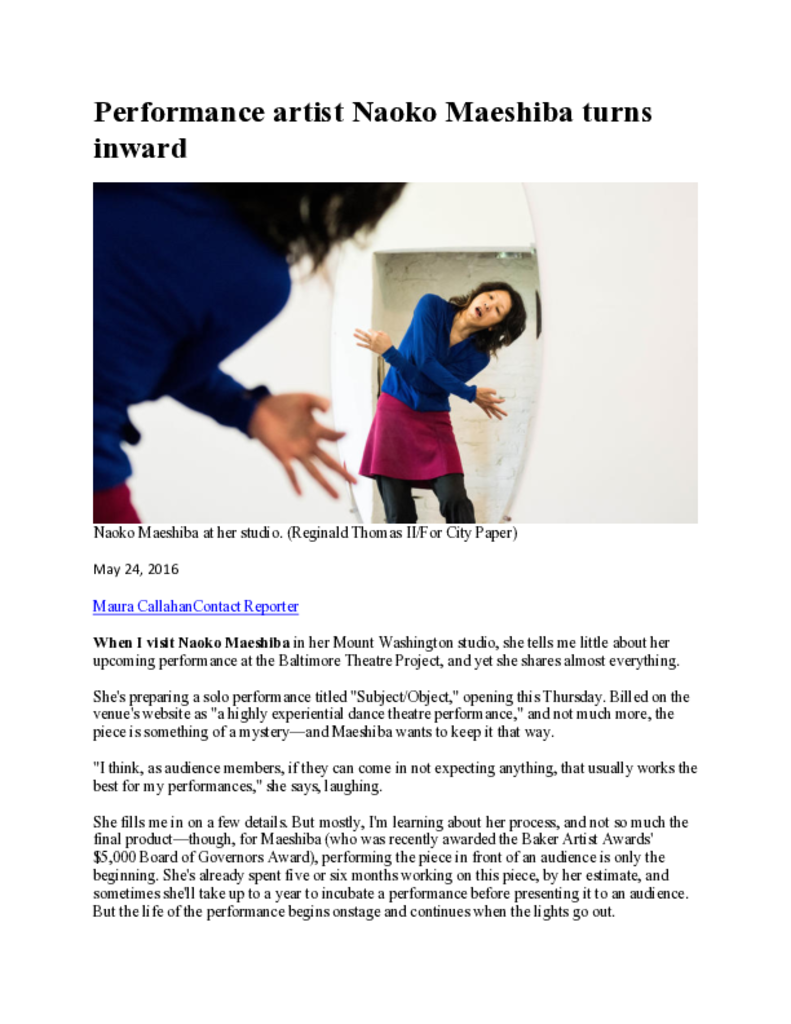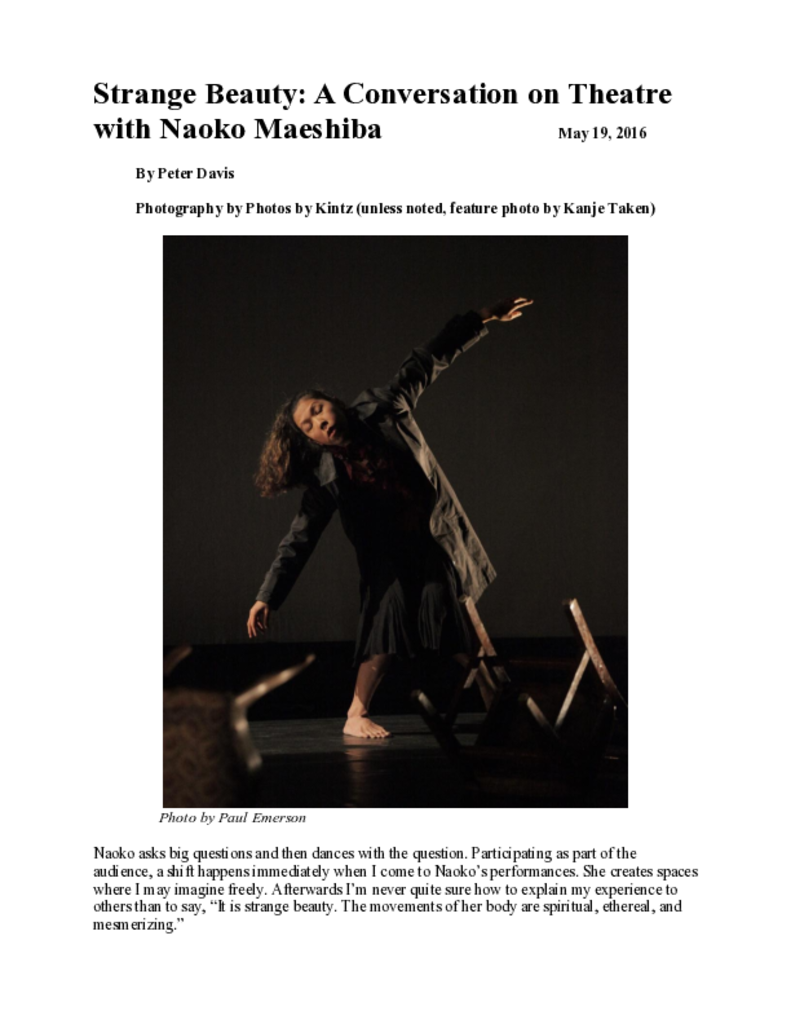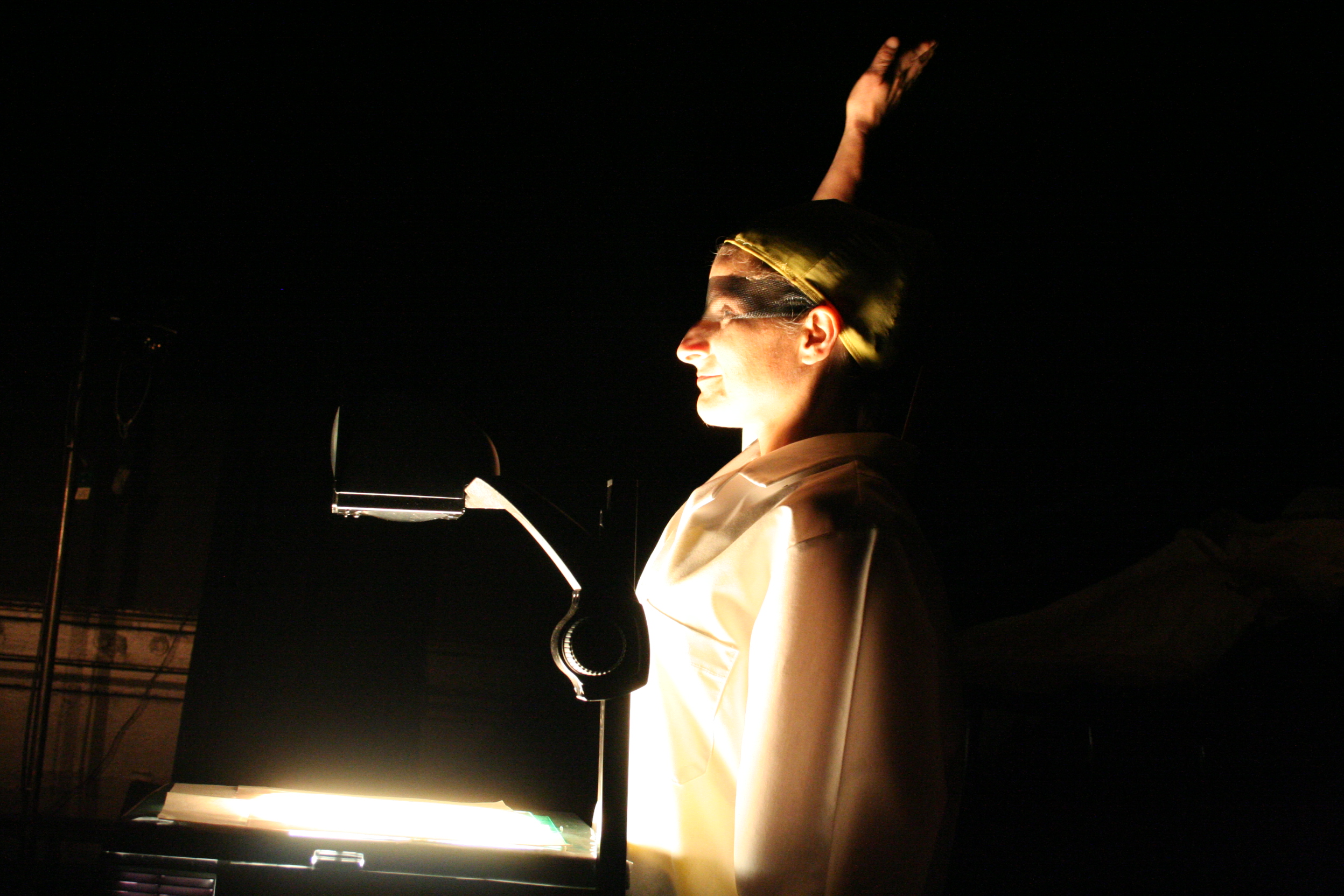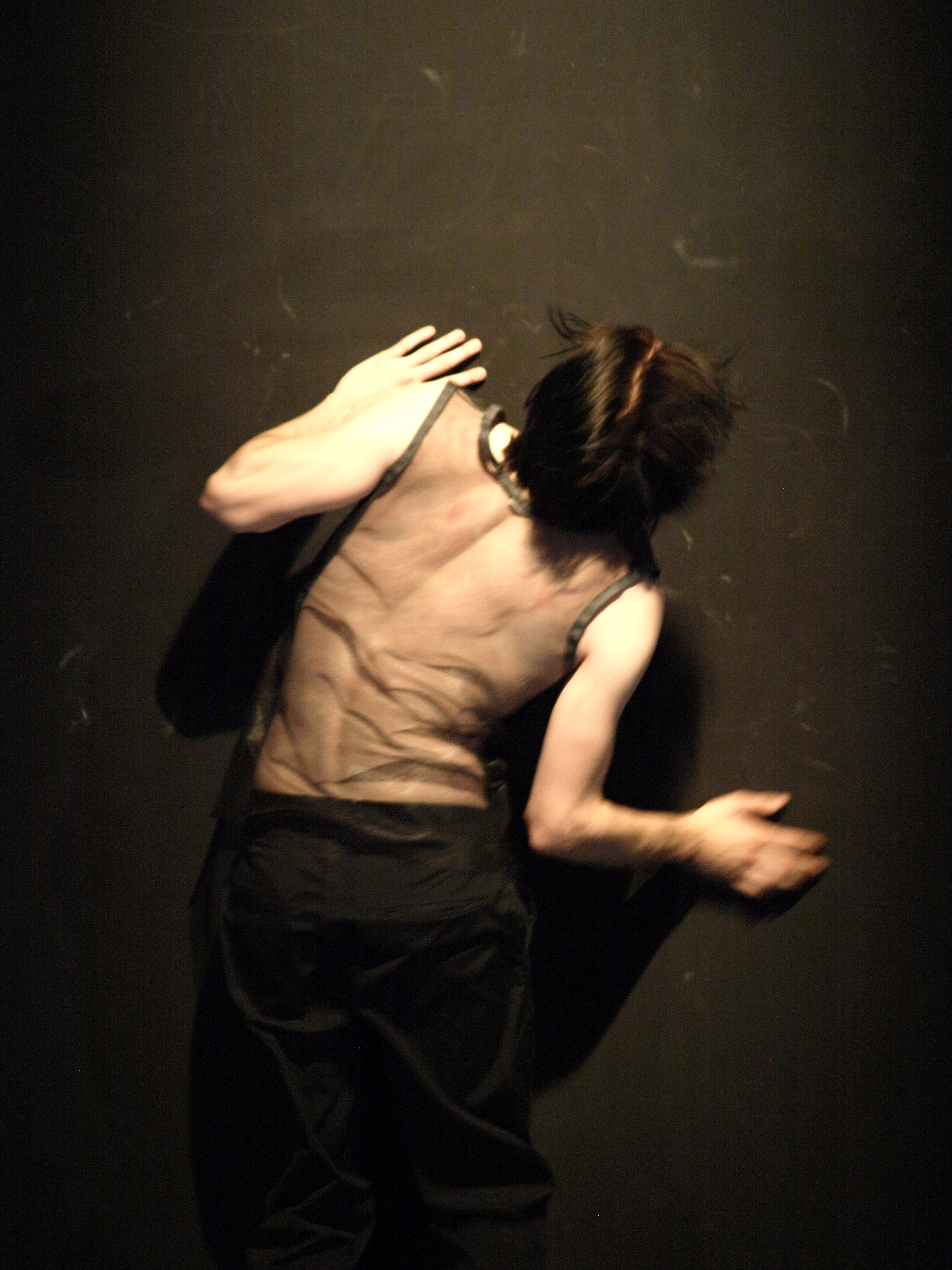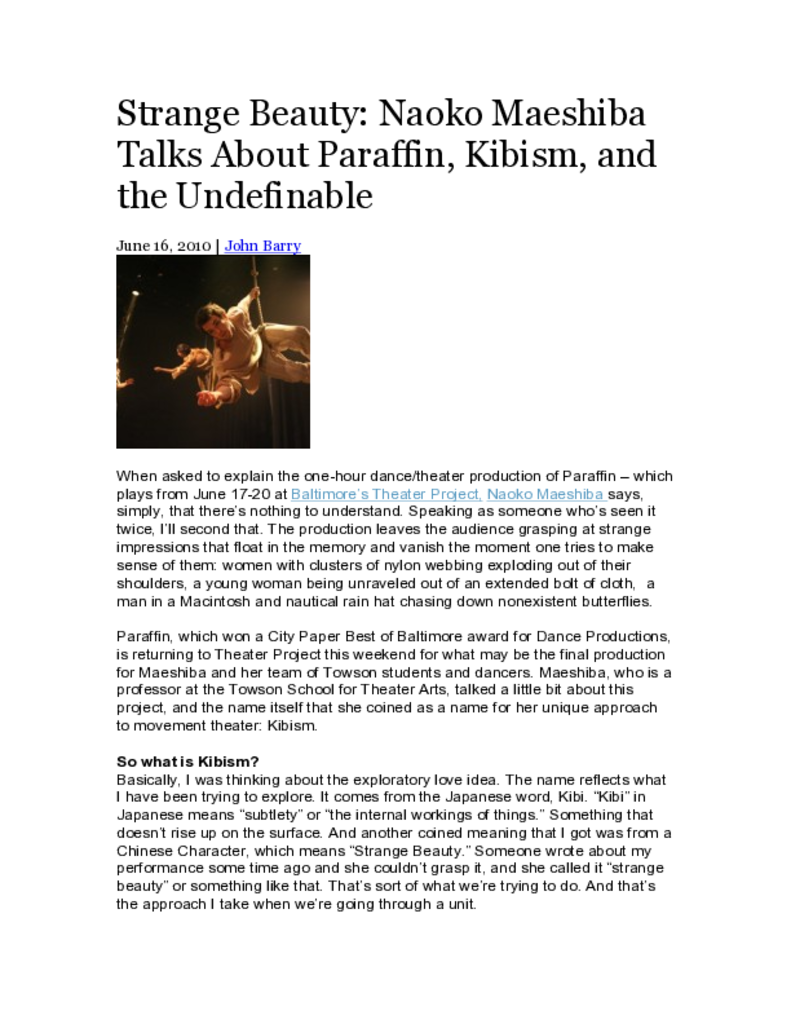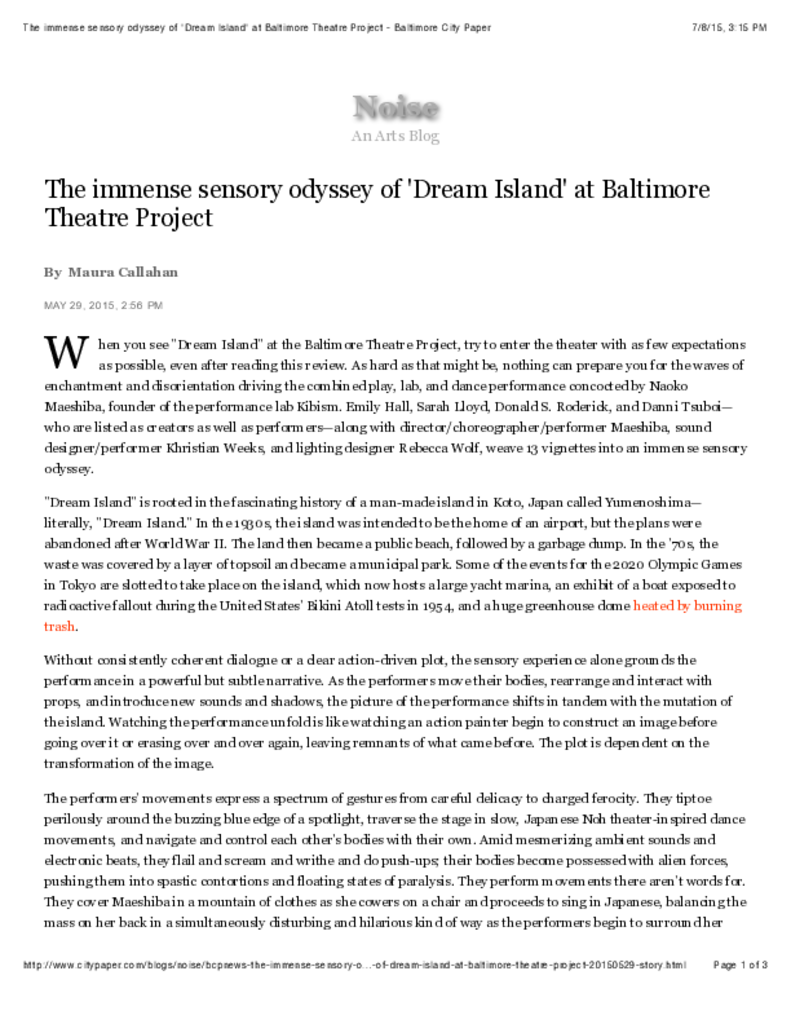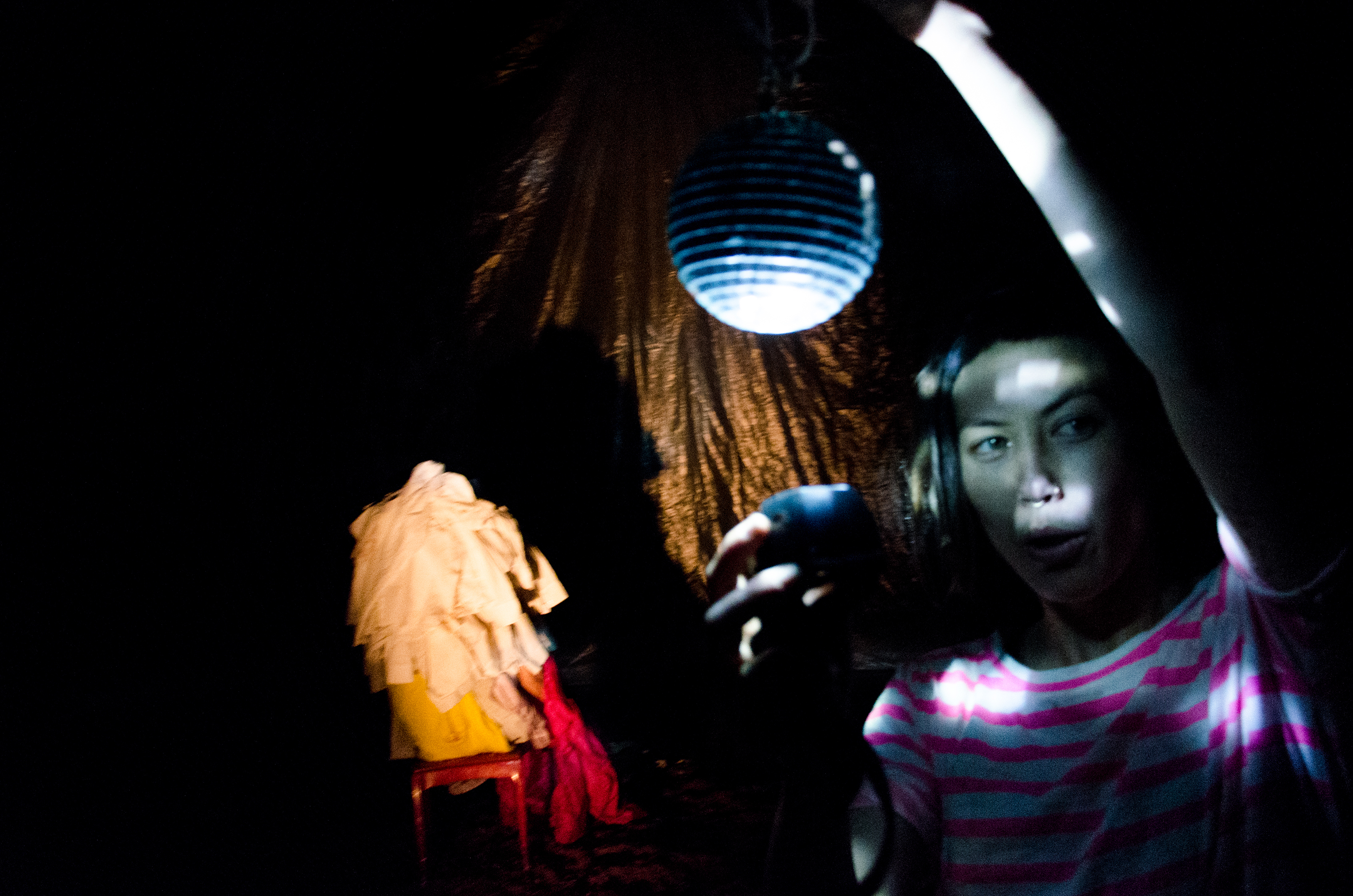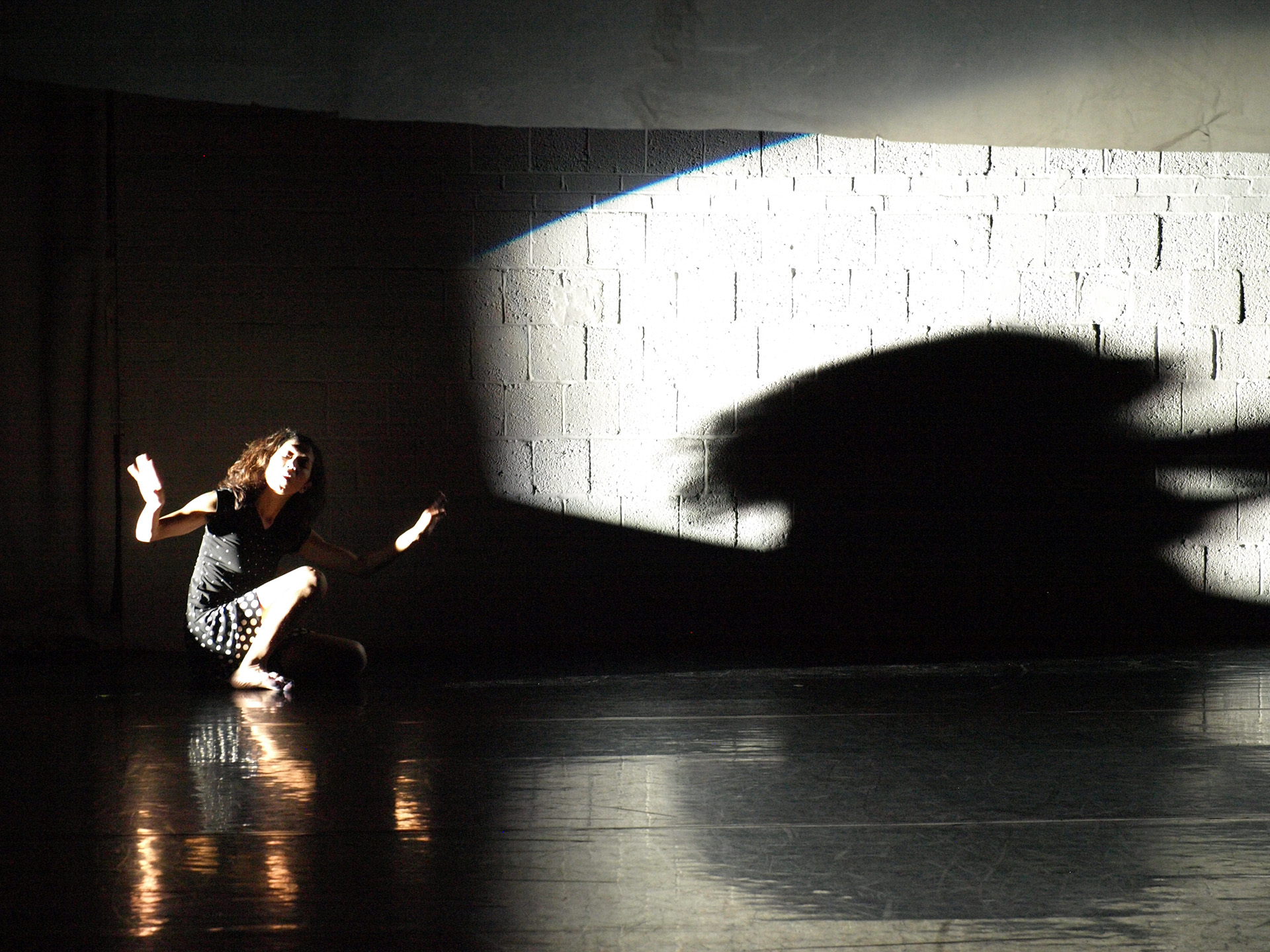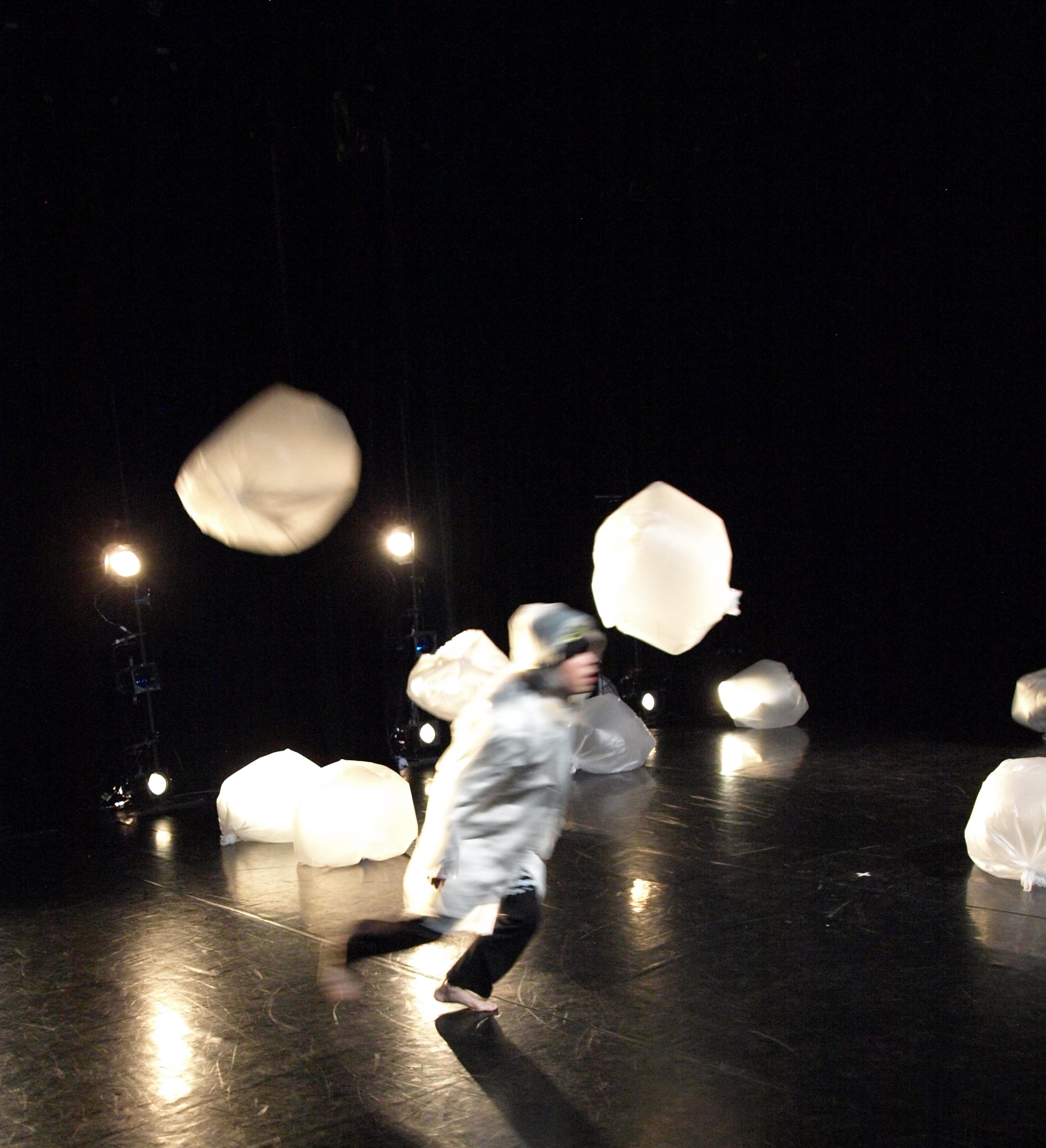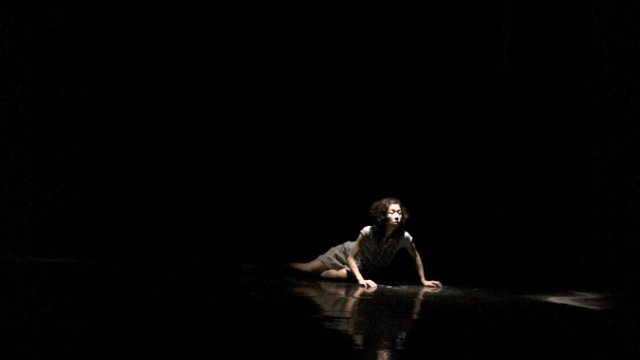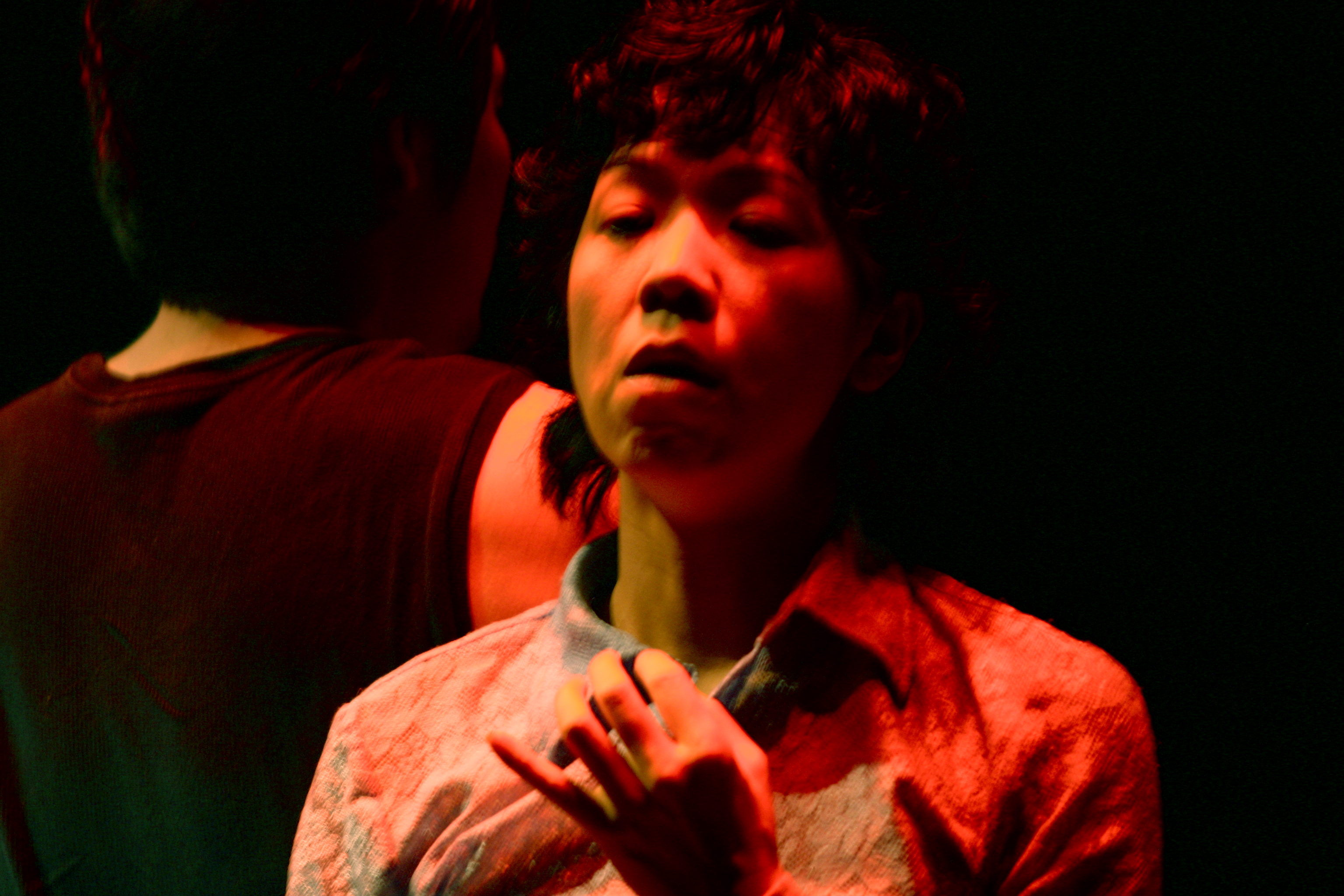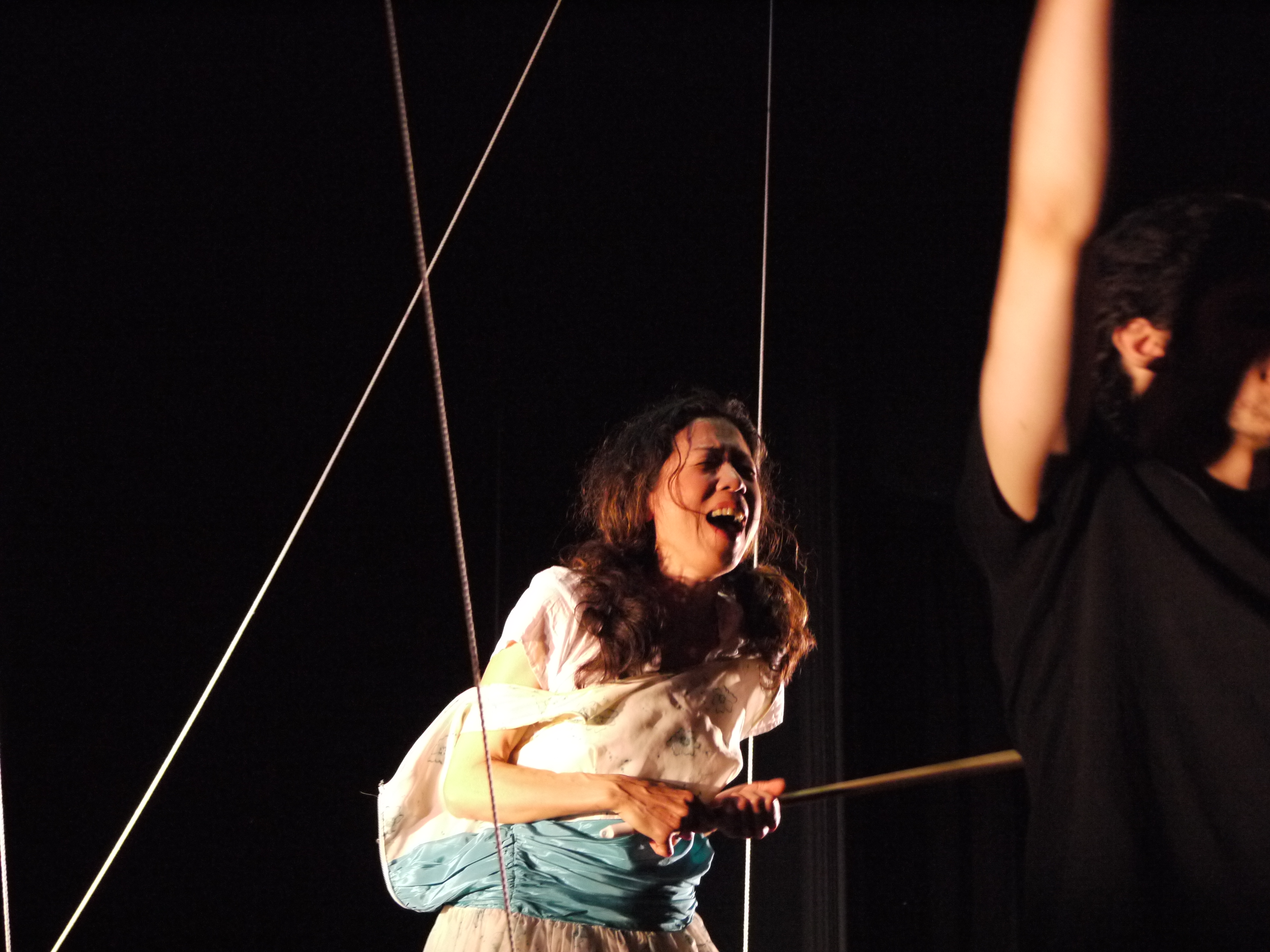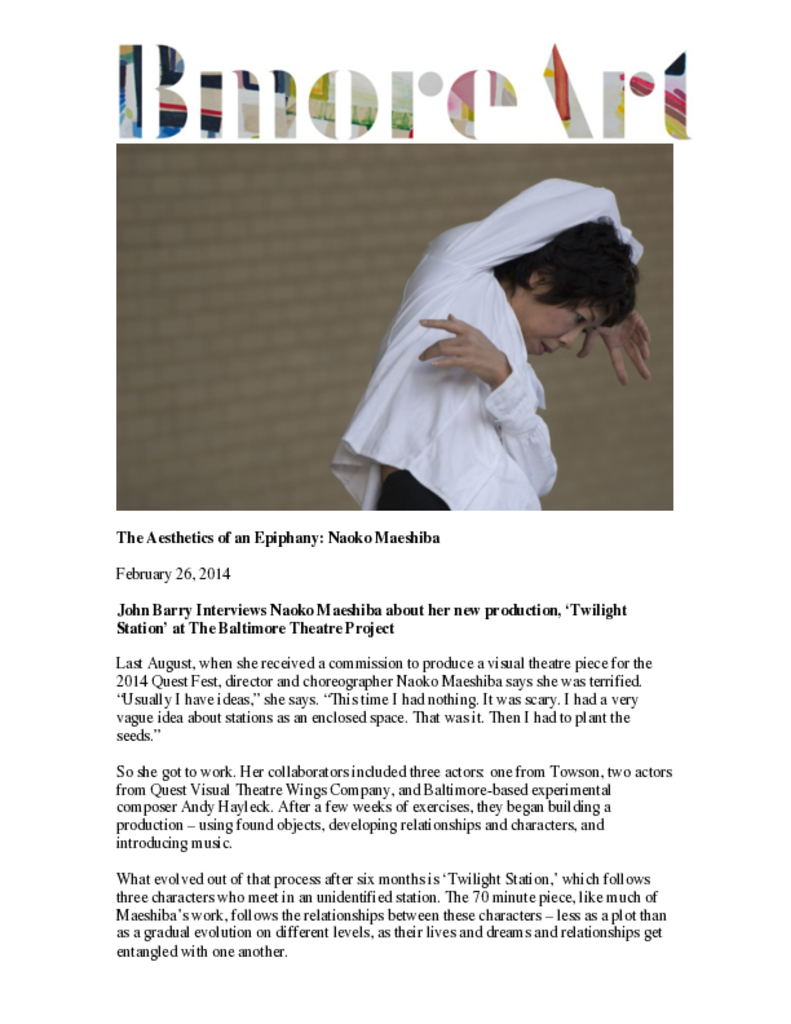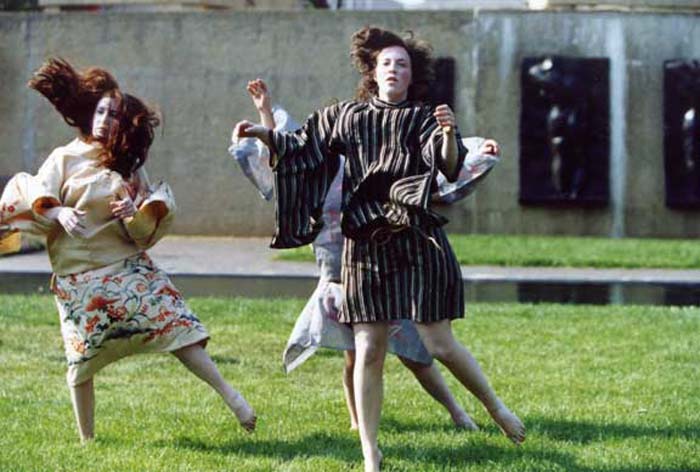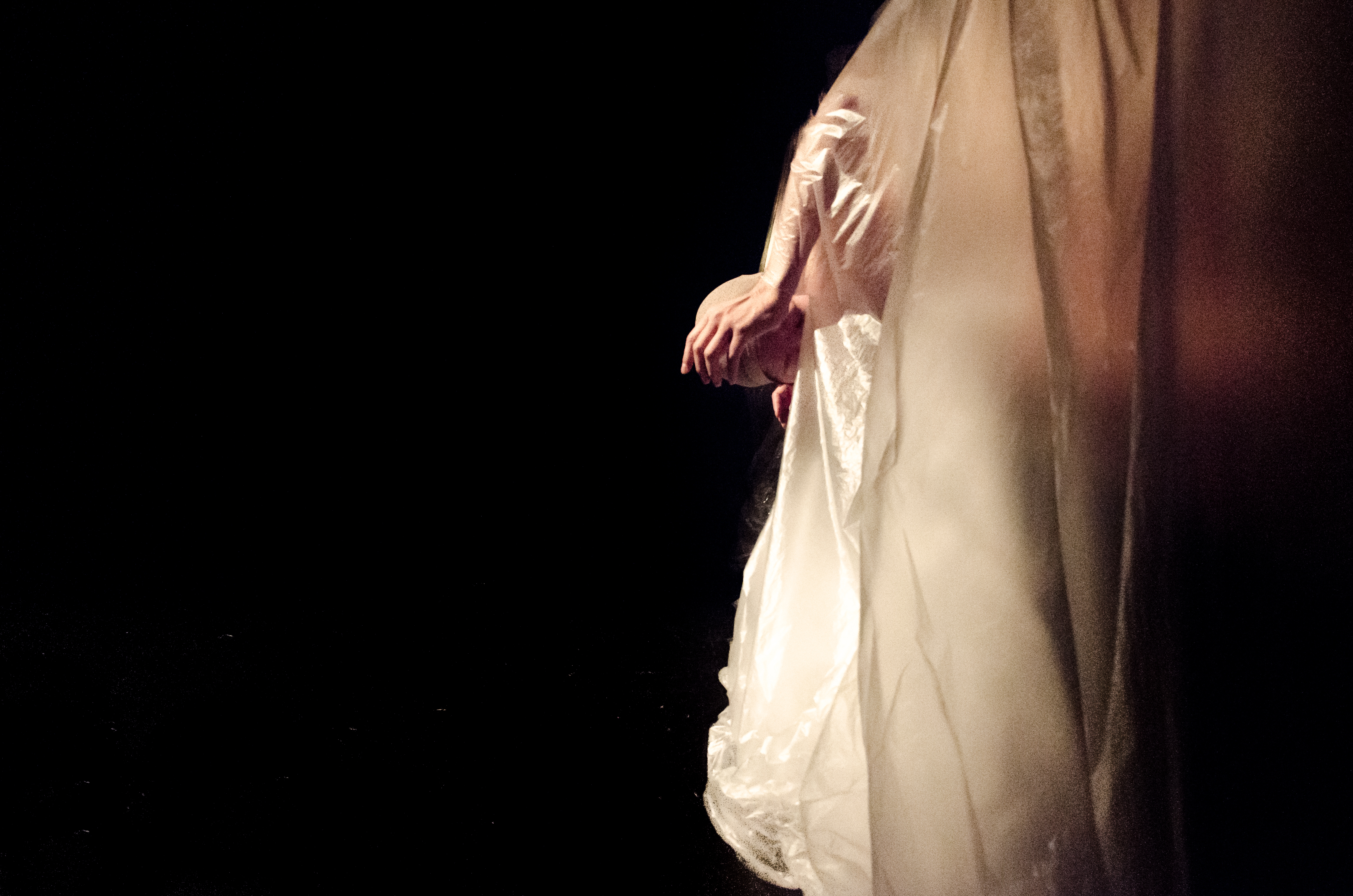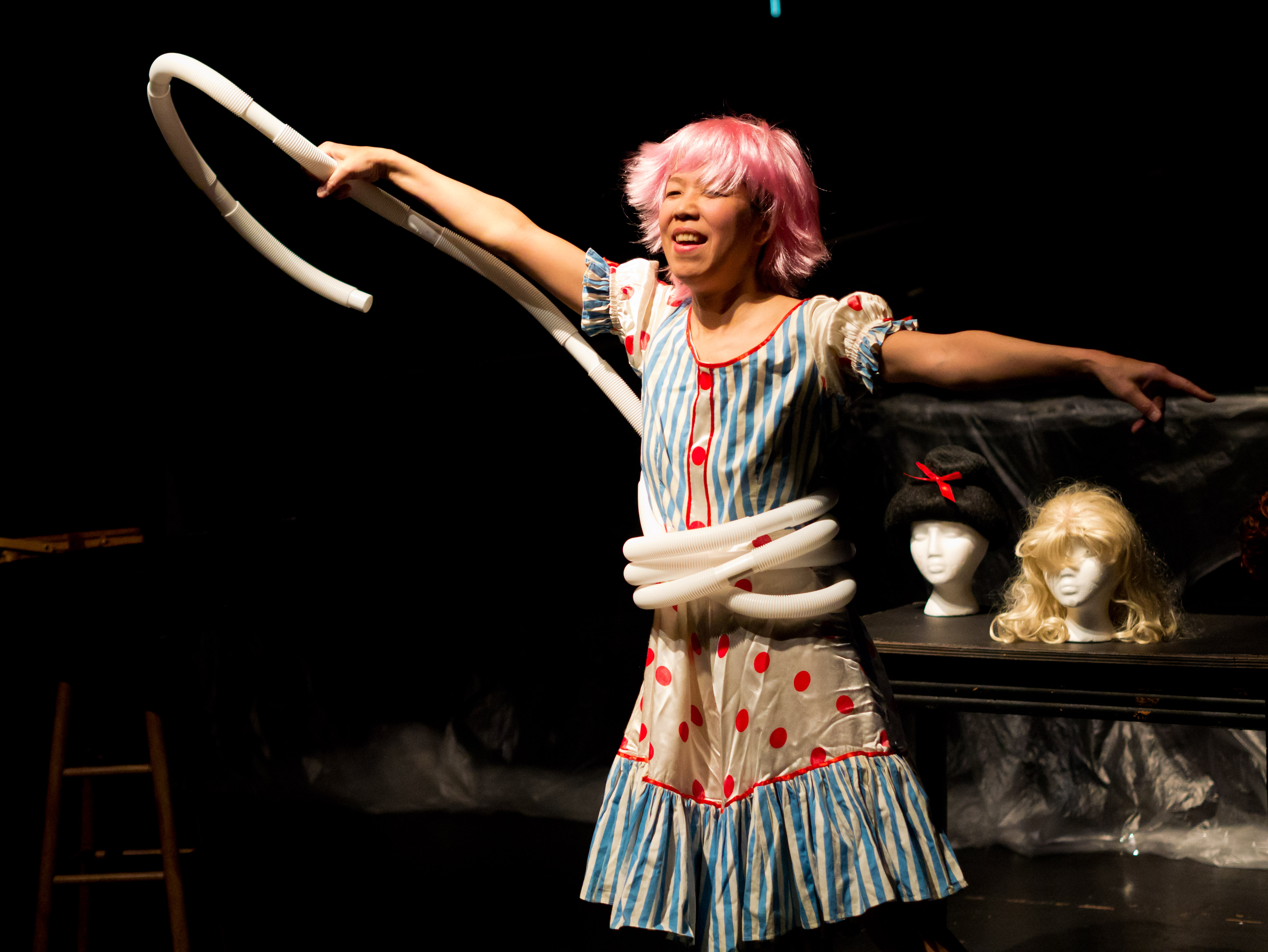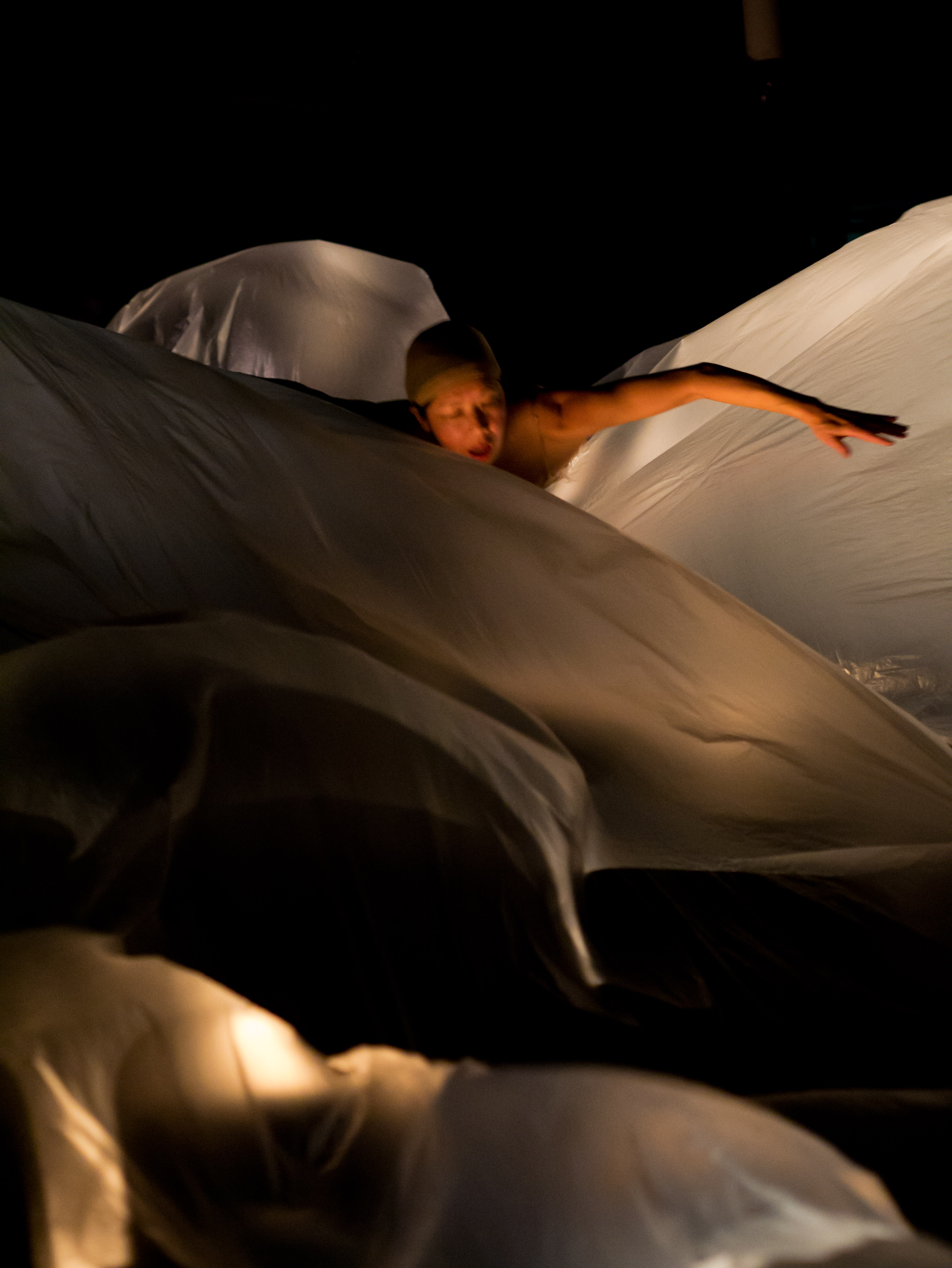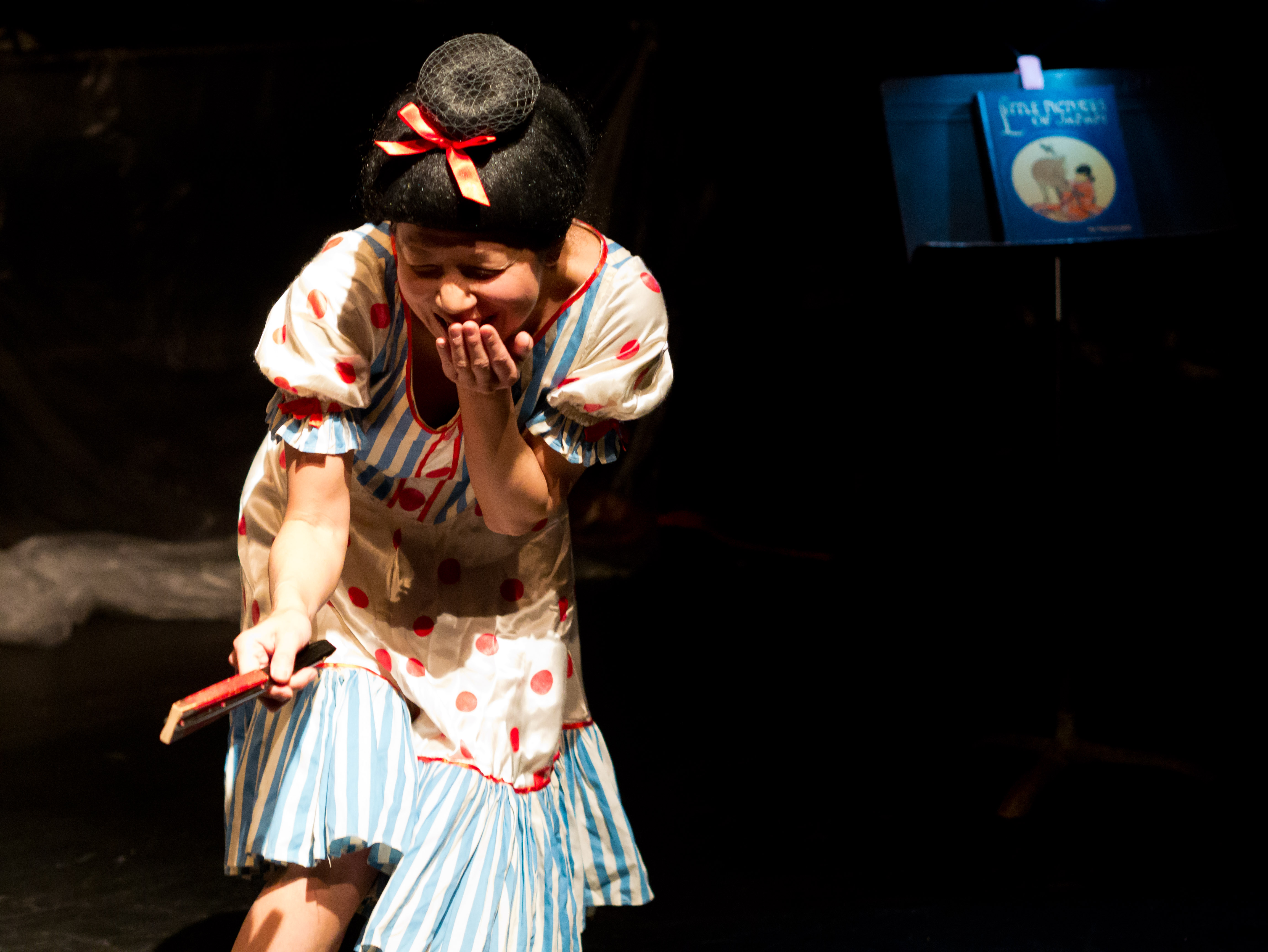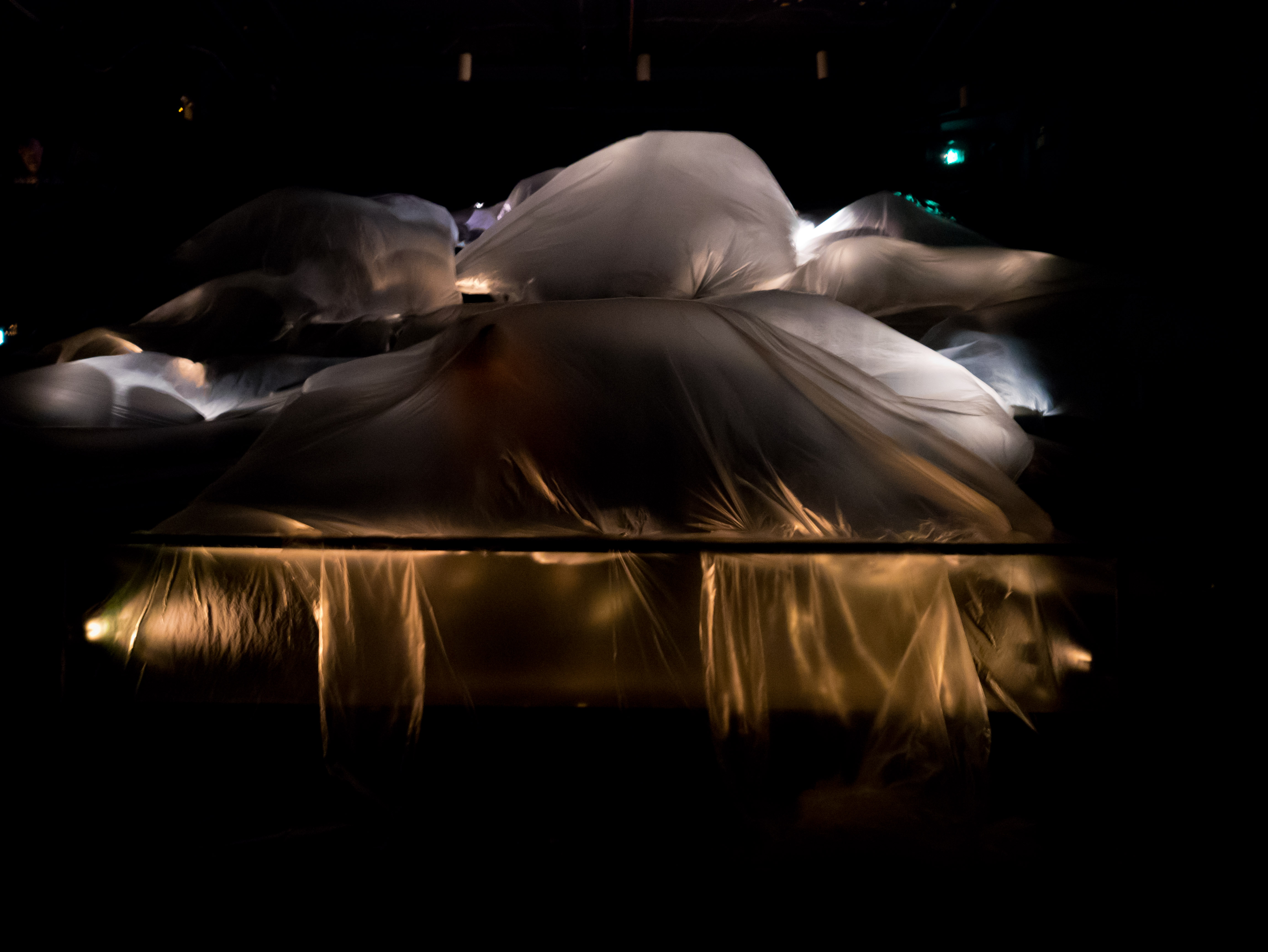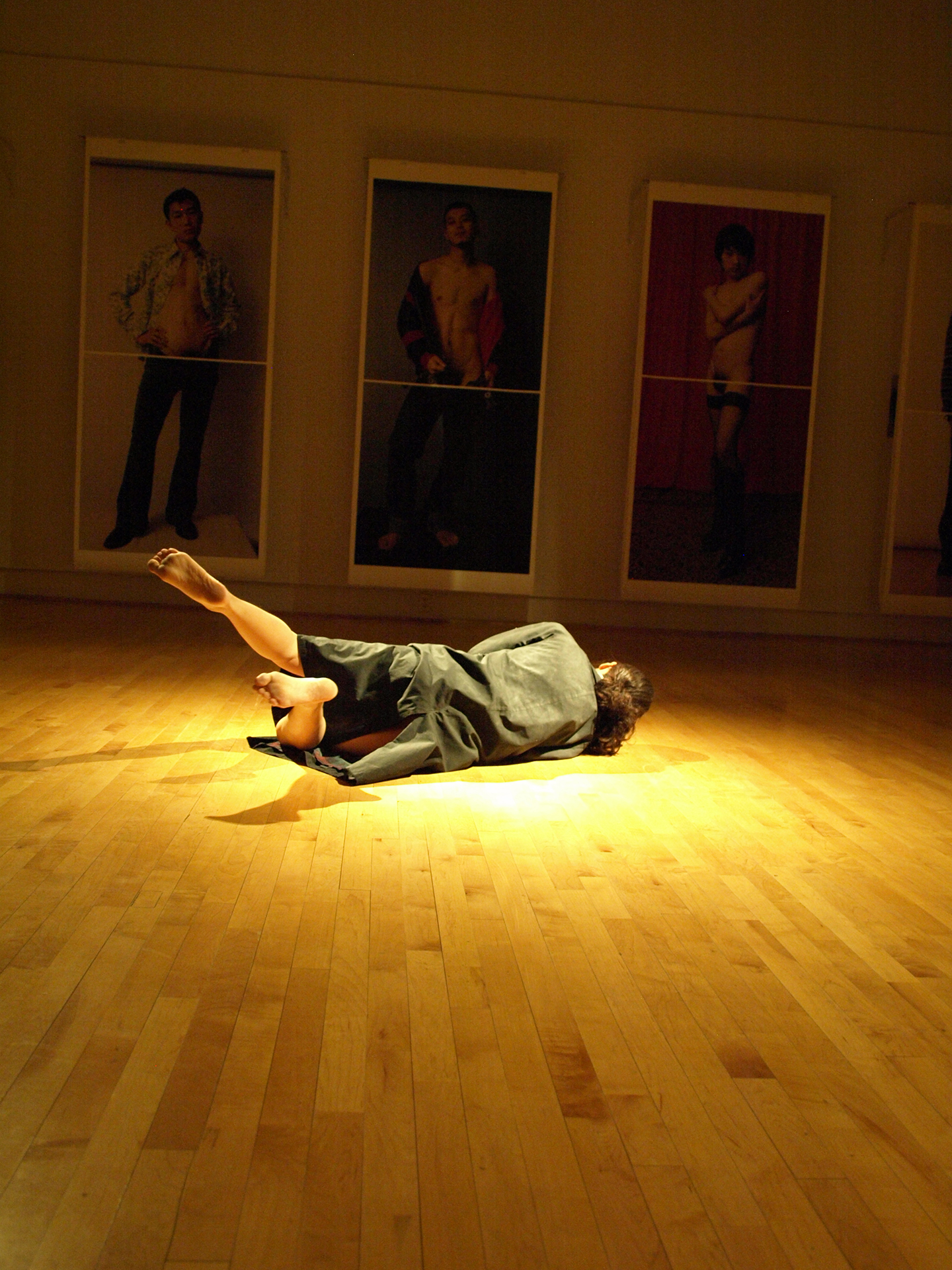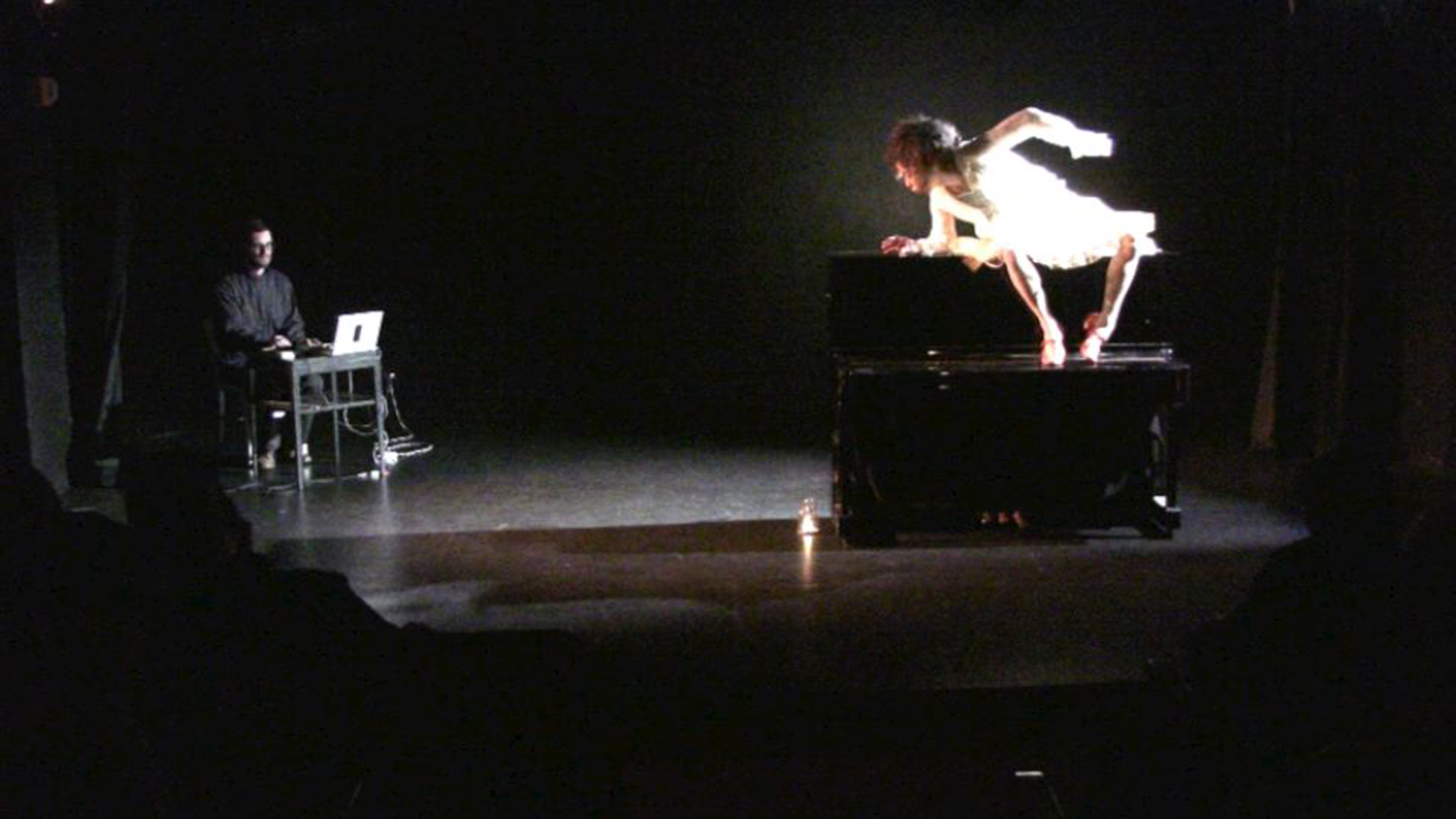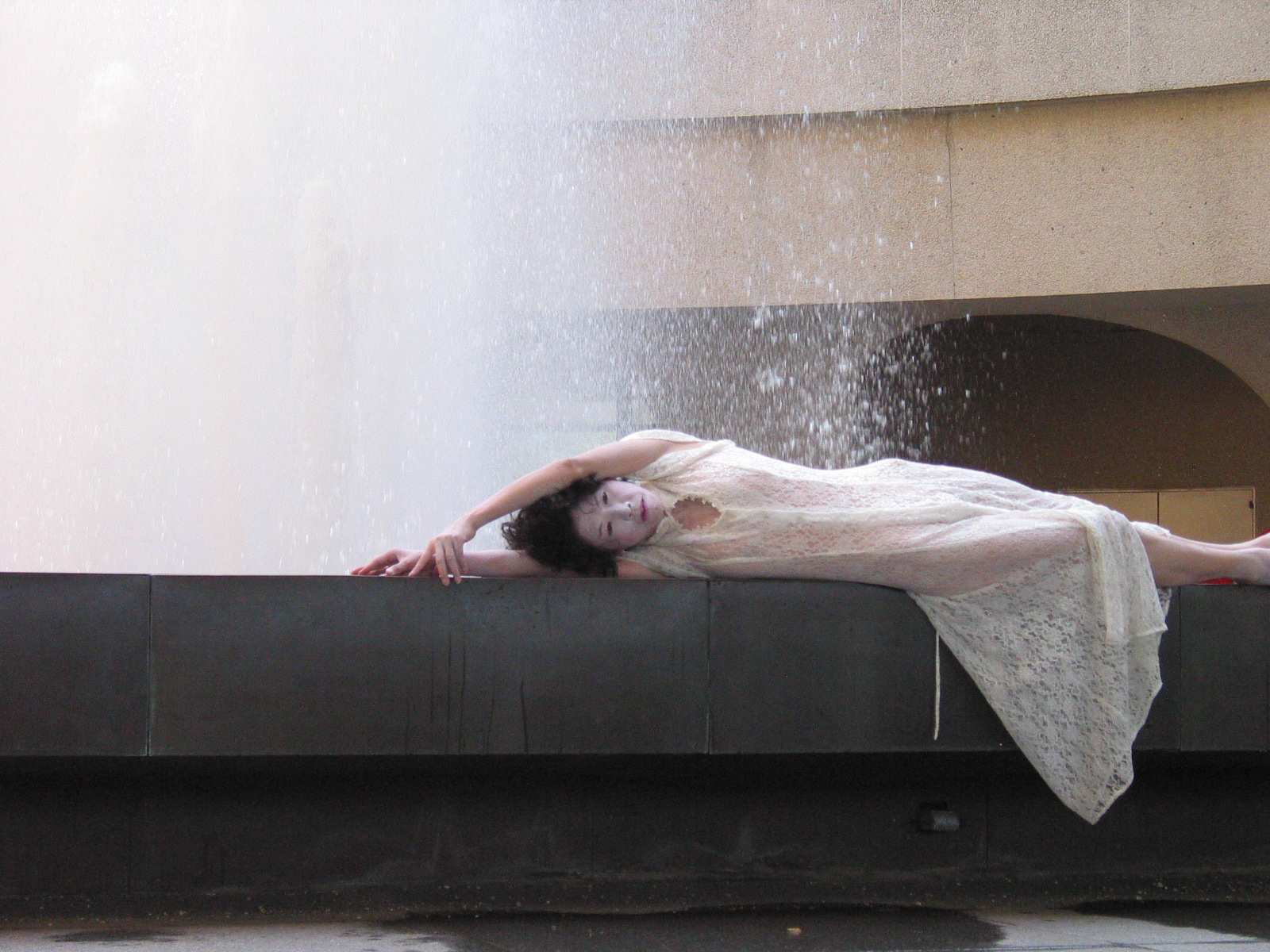Work samples
-
Naoko Maeshiba Collection of WorksDancer, Choreographer, Director, Designer. Born in Kobe, Japan, NAOKO MAESHIBA has been presenting works nationally and internationally since 1998. With the body as her central medium, she aspires to awaken the fuller potential of human perception and imagination by creating a visceral experience for her audience. Rooted in the minimalism of Japanese Noh theatre and post-modern Butoh dance as well as improvisation and surrealism, her work strives to unveil the unconscious and the invisible realm of human experience through the interplay of kinetic, auditory, and sculptural elements. Maeshiba’s work has been referred to as "strangely beautiful”, “emotionally engaging“, and “exquisite moving work of art“. “... the type of work that deliberately defies categorization” – The Baltimore Sun
About Naoko
Baltimore City

I have been creating solo, duo, and ensemble performances in traditional and non-traditional venues since 1998. Body is my instrument and my medium. My approach is interdisciplinary in terms of the source, the process, and the form. The seed of creation germinates from various elements such as sound, light, a piece of text, a painting, a map, an object, a piece of clothing, and a scientific phenomenon. I build precisely structured short and full-length pieces from scratch as well as collaborate… more
Jump to a project:
NAOKO MAESHIBA: A Total Artist Dancing on the edge of Theatre
Originally from Kobe, Japan, NAOKO MAESHIBA performs, choreographs, directs, designs, and teaches, all from the body’s point of view. Growing up in rural Japan nurtured her sensitivity to and curiosity about the life cycles of living creatures and the atmosphere of places and people. This environment cultivated her perceptions and sensory awareness.
Her work is rooted in the minimalism of Japanese Noh theatre and post-modern Butoh dance as well as improvisation and surrealism, her work strives to awaken the unconscious and the invisible realm of human experience through the interplay of kinetic, auditory, and sculptural elements.
Maeshiba has been commissioned to create works by Quest International Visutal Theatre, DC Local Dance Commissioning Project, and Dance Place, DC. Maeshiba has received the Individual Artist Fellowship Grant from DC Commissions on Arts and Humanities, Board of Governor Baker award (2016), Ruby grant (2015), and “B” grant (2011) from Greater Baltimore Cultural Alliance. She was given individual artist award five times from Maryland State Arts Council in the area of solo dance performance, solo theatre performance, and choreography, and Baltimore City Paper's Best of Baltimore in 'Best dance performance' and 'Best performance artist' categories.
Her works have been presented in both traditional and non-traditional venues in the North America, Europe, and Japan including John. F. Kennedy Center of Performing Arts (DC), Hirshhorn Museum at Smithsonian Institute (DC), Theatre of Yugen Noh space (SF), Tank (NY), Joyce Soho (NY), Ko Festival of Performance in Amherst (MA), Baltimore Theatre Project (MD), Questfest (MD), Dialog of Four Cultures Festival (Lodz, Poland), International New Media Festival (Warsaw, Poland), International House of Tokyo (Tokyo, Japan), Theatre Jo (Tabor, Czech Republic), Dance Hakushu (Hakushu, Japan), Dance Place (DC), Warehouse Gallery (DC) and Woolly Mammoth Theatre (DC).
She is a certified Feldenkrais practitioner and the director of the interdisciplinary and experimental MFA in Theatre Arts program at Towson University.
-
 DELICATE ASSEMBLAGE - Remains of Shadow: Part II (2005-7), Amherst, MA - Environment designI give a lot of thought to the use of light, sound, music and stage design to create environment and mood. The totality of how all these elements merge and coalesce together is crucial for my work in order to realize many layers of visual/auditory/kinetic experience for the audience. I carefully construct the environment considering the elements such as color, shape, texture, direction, and relationship between them.
DELICATE ASSEMBLAGE - Remains of Shadow: Part II (2005-7), Amherst, MA - Environment designI give a lot of thought to the use of light, sound, music and stage design to create environment and mood. The totality of how all these elements merge and coalesce together is crucial for my work in order to realize many layers of visual/auditory/kinetic experience for the audience. I carefully construct the environment considering the elements such as color, shape, texture, direction, and relationship between them. -
 TEN PERCENT ON STAGE, NINETY PERCENT IN AUDIENCES' MINDS - Twilight Station (2014), Baltimore, MD - Environment design"John Barry: My editor wondered whether your work was closer to dance than theatre. How do you respond to that? Naoko Maeshiba: Here’s my answer: Someone called it ‘Dancing on the Edge of Theater.’ I don’t think dance people consider it dance. Theatre people don’t consider it theatre. I’m exploring this non-categorized performance… It would be hard to write about it if you think theatre begins with a script. They might be looking for something that isn’t there — plot, characters, how the director executed his or her vision, but there’s no real plot line, the thing about my work is that the beginning keeps unfolding and gets explored and excavated and evolves. It may be hard to locate the climax or the story. There are stories, but there are multiple threads. My ongoing question is: where is performance happening? I ask my students, what would you prefer – if one hundred percent happens on stage, and people have to figure all that out. JB: What would you prefer? NM: I want ten percent happening on stage to ninety percent happening in the mind of the audience. I would want to move my finger and have the audience construct a whole story from that. That would be my dream. - BMore Art interview: The Aesthetics of an Epiphany
TEN PERCENT ON STAGE, NINETY PERCENT IN AUDIENCES' MINDS - Twilight Station (2014), Baltimore, MD - Environment design"John Barry: My editor wondered whether your work was closer to dance than theatre. How do you respond to that? Naoko Maeshiba: Here’s my answer: Someone called it ‘Dancing on the Edge of Theater.’ I don’t think dance people consider it dance. Theatre people don’t consider it theatre. I’m exploring this non-categorized performance… It would be hard to write about it if you think theatre begins with a script. They might be looking for something that isn’t there — plot, characters, how the director executed his or her vision, but there’s no real plot line, the thing about my work is that the beginning keeps unfolding and gets explored and excavated and evolves. It may be hard to locate the climax or the story. There are stories, but there are multiple threads. My ongoing question is: where is performance happening? I ask my students, what would you prefer – if one hundred percent happens on stage, and people have to figure all that out. JB: What would you prefer? NM: I want ten percent happening on stage to ninety percent happening in the mind of the audience. I would want to move my finger and have the audience construct a whole story from that. That would be my dream. - BMore Art interview: The Aesthetics of an Epiphany -
 TRADITIONAL INTO CONTEMPORARY - Improbable Encounter (2005), Lodz, KaliskaIn Japan, traditional theatre is still practiced as it was hundreds of years ago, maintaining its wealth of principles and philosophy. I wondered why this is the case and if the traditional and the contemporary could be a continuum, not separate entities. For the past twelve years, I have been studying Japanese Noh, 600-year old traditional Japanese performing art. Its principleswritten in Zeami's treatises continue to carry weight and value for today's performing arts. I bring Noh's principles into my contemporary work. Noh actors are like shamans, transmitting all kinds of spiritual power in the air through super precise movements and amorphous voice. This idea of 'performer as a vessel, a transmitter' resonates with me strongly. All principles of Noh are constructed to evoke maximum imagination with minimum execution. For instance, "Feel 10, show 7",means you express only 70% of the 100% you are feeling, leaving the rest for the audience' to figure out. "Sight outside of sight" refers to the performer’s ability to perceive 360 degree awareness in order to objectively see themselves in a larger context.
TRADITIONAL INTO CONTEMPORARY - Improbable Encounter (2005), Lodz, KaliskaIn Japan, traditional theatre is still practiced as it was hundreds of years ago, maintaining its wealth of principles and philosophy. I wondered why this is the case and if the traditional and the contemporary could be a continuum, not separate entities. For the past twelve years, I have been studying Japanese Noh, 600-year old traditional Japanese performing art. Its principleswritten in Zeami's treatises continue to carry weight and value for today's performing arts. I bring Noh's principles into my contemporary work. Noh actors are like shamans, transmitting all kinds of spiritual power in the air through super precise movements and amorphous voice. This idea of 'performer as a vessel, a transmitter' resonates with me strongly. All principles of Noh are constructed to evoke maximum imagination with minimum execution. For instance, "Feel 10, show 7",means you express only 70% of the 100% you are feeling, leaving the rest for the audience' to figure out. "Sight outside of sight" refers to the performer’s ability to perceive 360 degree awareness in order to objectively see themselves in a larger context. -
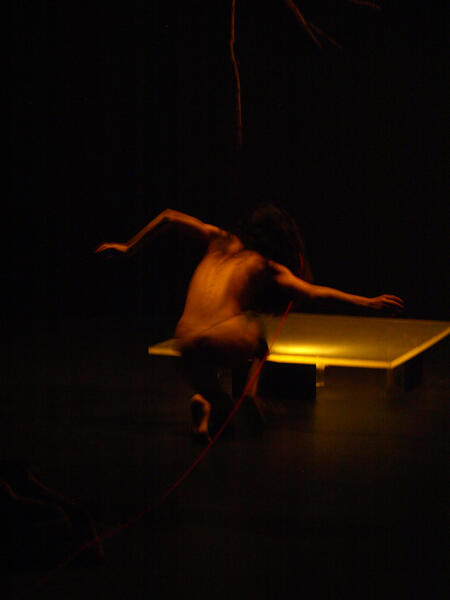 APPROACHING THE INVISIBLEI'm increasingly interested in what's happening underneath the surface. I'm more interested in choreographing senses, not the movements. Movements are driven by the inner imperceptible vibrations, sensations, and emotions. Human beings understand more through the 'unspoken, invisible' than through the 'spoken, visible'. I'd like to extract the essence that lies in what is not seen, but sensed.
APPROACHING THE INVISIBLEI'm increasingly interested in what's happening underneath the surface. I'm more interested in choreographing senses, not the movements. Movements are driven by the inner imperceptible vibrations, sensations, and emotions. Human beings understand more through the 'unspoken, invisible' than through the 'spoken, visible'. I'd like to extract the essence that lies in what is not seen, but sensed. -
Interview with Maryland Public Television (2004)Naoko Maeshiba talks about her work "Voyage" and her creative process.
-
 MY BODY MERGES WITH THE ENVIRONMENT, MY BODY IS THE ENVIRONMENT - When the wind crossed my body cried like an octopus (2010) Tabor, Czech RepublicBody is my medium of exploration. It's a lens to see the society, the world. It's a vessel to transmit my sensory experience of the incoming stimuli into dance. My exploration of the relationship between body and environment is on-going. I choose a site to place my body, drawing the life force inherent in the place. I would like to be able to dance the place.
MY BODY MERGES WITH THE ENVIRONMENT, MY BODY IS THE ENVIRONMENT - When the wind crossed my body cried like an octopus (2010) Tabor, Czech RepublicBody is my medium of exploration. It's a lens to see the society, the world. It's a vessel to transmit my sensory experience of the incoming stimuli into dance. My exploration of the relationship between body and environment is on-going. I choose a site to place my body, drawing the life force inherent in the place. I would like to be able to dance the place. -
IMPROVISATION/COLLABORATION (2007) - 'High Zero Festival' @ Baltimore Theatre Project - Improvisational danceAs a dancer and a choreographer, I aspire to capture and connect with the immediate living moment as deeply and precisely as possible. For this reason, I am choosing IMPROVISATION as my fundamental approach to work. My body is a transmitter of all living beings. When I enter the most potent state of the body, I merge with the ongoing currents around me. I'm becoming the particles of this flow that is continuously moving and changing. In order to challenge my own boundary and limitations, I COLLABORATE with a wide range of musicians and visual artists. Collaboration with Cooper Moore (self-made instruments) and Catherine Pancake (dry ice), Kazuhisa Uchihashi (guitar, electronics).
Yearning for THE ETERNAL: Paraffin (2009-2010)
"Paraffin" was probably one of the most complex pieces I've created in terms of both creative process and the final production. Layers in the dramatic structure and multiple sensory tracks made space for the audience to choose and follow the threads they created.
The piece consisted of eleven vignettes with the total time of 75 minutes.
******************************************************************************************
PARAFFIN (2009-2010) - full-length
Concept, choreography, direction, environment/object design, and performance
Growing up in Japan, I have followed all kinds of codes and formulas society has placed on us. Whether they are explicit or implicit, they have definitely formed my body and mind over the years without my being always conscious about their effect. I have also been becoming more and more aware of how compartmentalized our world is and how we make assumptions based on categories and labels. I wanted to examine how our response to this force manifests in everyday life. Several characters were selected who could be considered as the outsiders to the society. Dramaturgically, the piece is housed in the context of the parallel journeys of an insect collector who has disappeared in the dunes and has been forgotten by the society and a creature who was born in a civilized society and gotten abandoned.
In order to explore this theme, I wanted to play with the space both vertically (connection with the spiritual, extraordinary) and horizontally (immediate environment, everyday). Mara Neimanis, a local aerial performer, trained us to be able to work in the air. Performers also went through the physical training with me that allowed them to cultivate precise and subtle physicality.
My inspiration came from two places: books ("The Woman in the Dunes” by Kobo Abe and “Unfashionable Human Body” by Bernard Rudofsky) and material (paraffin paper). I remembered this paper from the book cover of a Japanese publishing company. The tactile feel of this paper, its color and translucent quality stuck on my sense memory. It created murky mysterious mood.
Paraffin paper was used both tangible object and as the physical and visual metaphor in creating characters and scenes and asa motif to weave multiple stories together. A non-verbal, non-linear narrative structure allowed the audience to create their own versions of the stories.
Material - Paraffin paper, ropes
Lighting design by Kel Millionaire, Rebecca Wolf
Costume design by Kathy Abbott
Mask design by Susan Stroupe
Received Best Dance Performance in Citypaper Best of Baltimore 2009.
Premiere - June 2009 @ Baltimore Theatre Project
Tour - March 2010 @Quest International Visual Theatre Festival, Washington DC, April 2010 Dance Place, Washington DC
The piece consisted of eleven vignettes with the total time of 75 minutes.
******************************************************************************************
PARAFFIN (2009-2010) - full-length
Concept, choreography, direction, environment/object design, and performance
Growing up in Japan, I have followed all kinds of codes and formulas society has placed on us. Whether they are explicit or implicit, they have definitely formed my body and mind over the years without my being always conscious about their effect. I have also been becoming more and more aware of how compartmentalized our world is and how we make assumptions based on categories and labels. I wanted to examine how our response to this force manifests in everyday life. Several characters were selected who could be considered as the outsiders to the society. Dramaturgically, the piece is housed in the context of the parallel journeys of an insect collector who has disappeared in the dunes and has been forgotten by the society and a creature who was born in a civilized society and gotten abandoned.
In order to explore this theme, I wanted to play with the space both vertically (connection with the spiritual, extraordinary) and horizontally (immediate environment, everyday). Mara Neimanis, a local aerial performer, trained us to be able to work in the air. Performers also went through the physical training with me that allowed them to cultivate precise and subtle physicality.
My inspiration came from two places: books ("The Woman in the Dunes” by Kobo Abe and “Unfashionable Human Body” by Bernard Rudofsky) and material (paraffin paper). I remembered this paper from the book cover of a Japanese publishing company. The tactile feel of this paper, its color and translucent quality stuck on my sense memory. It created murky mysterious mood.
Paraffin paper was used both tangible object and as the physical and visual metaphor in creating characters and scenes and asa motif to weave multiple stories together. A non-verbal, non-linear narrative structure allowed the audience to create their own versions of the stories.
Material - Paraffin paper, ropes
Lighting design by Kel Millionaire, Rebecca Wolf
Costume design by Kathy Abbott
Mask design by Susan Stroupe
Received Best Dance Performance in Citypaper Best of Baltimore 2009.
Premiere - June 2009 @ Baltimore Theatre Project
Tour - March 2010 @Quest International Visual Theatre Festival, Washington DC, April 2010 Dance Place, Washington DC
-
PARAFFIN (2009-2010)
-
 Paraffin (2009-2010)@ Baltimore Theatre Project (MD), Questfest/ Dance Place (DC)The inspector prepares her equipment to examine the creature. We decided to use an overhead projector to draw and erase on the creature, obliterating her identity. This analog device added a touch of humor to this unsettling moment.
Paraffin (2009-2010)@ Baltimore Theatre Project (MD), Questfest/ Dance Place (DC)The inspector prepares her equipment to examine the creature. We decided to use an overhead projector to draw and erase on the creature, obliterating her identity. This analog device added a touch of humor to this unsettling moment. -
 Paraffin (2009-2010)@ Baltimore Theatre Project (MD), Questfest/ Dance Place (DC)Drawing from the insect collector character from 'The Woman in the Dunes", the motif of insect permeated through the whole piece. It appeared in the material of the costumes, the color and temperature of light, and the texture of the sound.
Paraffin (2009-2010)@ Baltimore Theatre Project (MD), Questfest/ Dance Place (DC)Drawing from the insect collector character from 'The Woman in the Dunes", the motif of insect permeated through the whole piece. It appeared in the material of the costumes, the color and temperature of light, and the texture of the sound. -
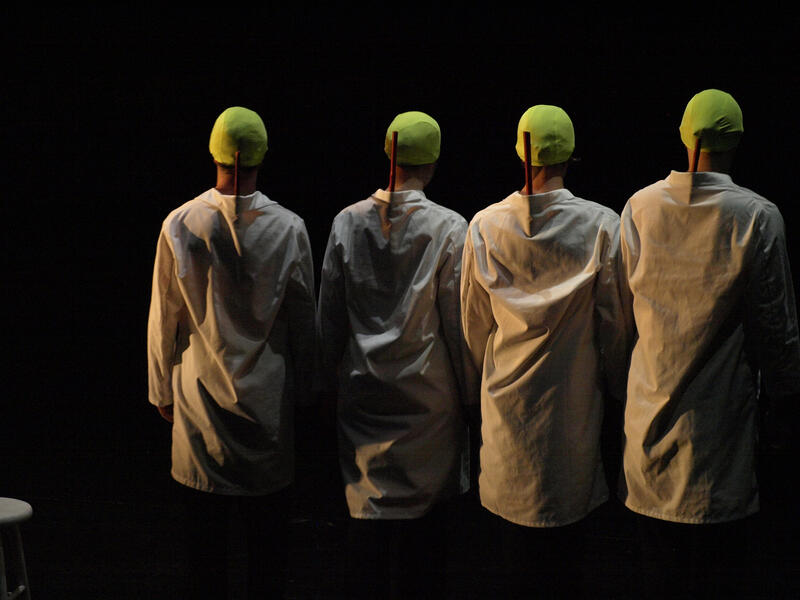 Paraffin (2009-2010)@ Baltimore Theatre Project (MD), Questfest/ Dance Place (DC)The inspectors prepare to examine a found creature. They have red super straight spines which they use to measure the creature.
Paraffin (2009-2010)@ Baltimore Theatre Project (MD), Questfest/ Dance Place (DC)The inspectors prepare to examine a found creature. They have red super straight spines which they use to measure the creature. -
 Paraffin (2009-2010)@ Baltimore Theatre Project (MD), Questfest/ Dance Place (DC)..."left a powerful emotional imprint by exposing the consequences of forgetting or disregarding someone's humanity." – The Washington Post,
Paraffin (2009-2010)@ Baltimore Theatre Project (MD), Questfest/ Dance Place (DC)..."left a powerful emotional imprint by exposing the consequences of forgetting or disregarding someone's humanity." – The Washington Post, -
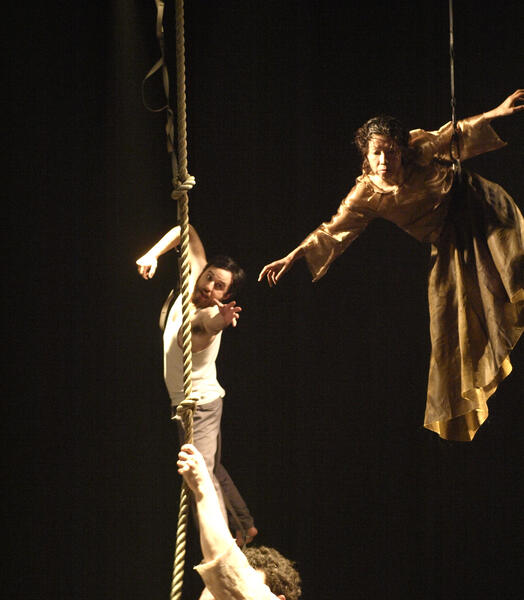 Paraffin (2009-2010)@ Baltimore Theatre Project (MD), Questfest/ Dance Place (DC)"...the performance evokes the raw passions of fear and desire as the body is stretched to its physical and expressive limits…” – Baltimore Theatre Journal
Paraffin (2009-2010)@ Baltimore Theatre Project (MD), Questfest/ Dance Place (DC)"...the performance evokes the raw passions of fear and desire as the body is stretched to its physical and expressive limits…” – Baltimore Theatre Journal -
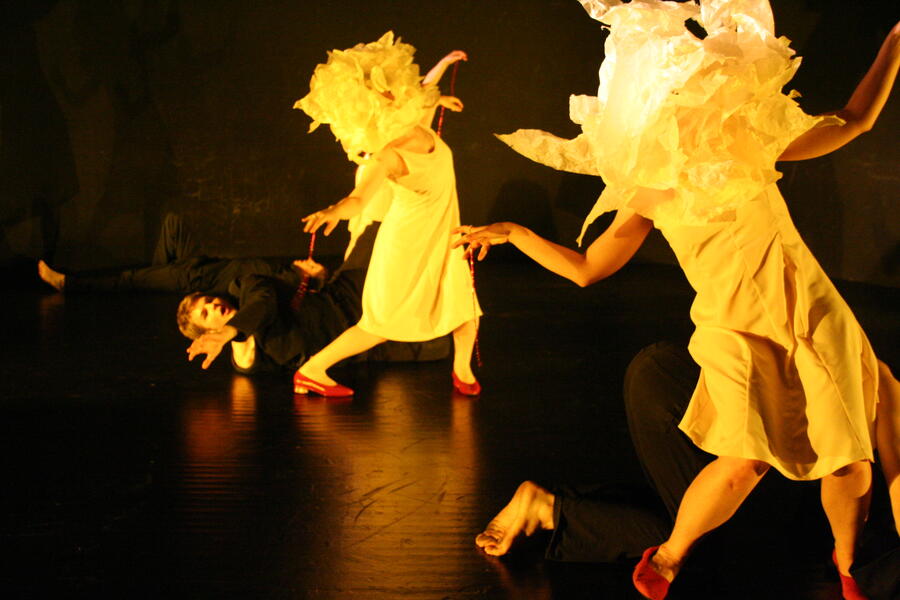 Paraffin (2009-2010)@ Baltimore Theatre Project (MD), Questfest/ Dance Place (DC)"...strikingly beautiful yet somewhat disturbing." - The Washington Post
Paraffin (2009-2010)@ Baltimore Theatre Project (MD), Questfest/ Dance Place (DC)"...strikingly beautiful yet somewhat disturbing." - The Washington Post -
 Paraffin (2009-2010) @ Baltimore Theatre Project (MD), Questfest/ Dance Place (DC)"A kinetic wonder" - Baltimore Theatre Journal
Paraffin (2009-2010) @ Baltimore Theatre Project (MD), Questfest/ Dance Place (DC)"A kinetic wonder" - Baltimore Theatre Journal
Illuinating the INVISIBLE: Dream Island (2015)/What we see Why we see (2012)
These two pieces used the same material, a huge plastic sheet that stood like a wall. I was obsessed by its texture, history and association, and translucent nature to be able to alter the visual perception. The wall came down and disappeared from the stage with no trace in both pieces. Fukushima, nuclear, and trash had been on my mind since 3.11 happened in Japan four years ago.
********************************************************************************************
DREAM ISLAND (2015) - full-length
Concept, choreography, direction, environment/object design, and performance
In March 2011, I heard a disturbing news that the radioactive material started leaking into the ocean near Fukushima nuclear plant. I had a visceral response to this - all the cells in my body cried out as if my own body got violated. My fond memories about water and ocean started coming back. A great sense of urgency hit me. This urge became the driving force of "Dream Island".
The piece through a three-year process from the conception to the realization. Dramaturgy was built upon the place in Japan called Yumenoshima (Dream Island), which was a Japanese theme park built on a buried landfill. Movement, text, and sound were generated, constructed, and polished through the nine-month rehearsal process. Piece was 85 minutes long consisting of 14 vignettes.
The stage was set up as a thrust configuration with a square on the floor made by a danger zone tape. Audience members were invited to sit around it.
Material: large plastic sheets, dirt
Lighting Design: Rebecca Wolf
Sound Design: Khristian Weeks
Premiere - May 2015 @ Baltimore Theatre Project, Tour - June 2015 @ Joe's Movement Emporium, MD
***********************************************
WHAT WE SEE WHY WE SEE (2012) - full-length
Co-conception, choreography, direction, environment, costume/object design, and performance with Tzveta Kassavoba
Memories and perceptions are strange things. We choose to see and memorize certain things, not others. A Bulgarian choreographer, Tzveta Kassabova, and I experimented with the visual perception. Plastic sheets and bags of different sizes were used as the source material to generate the context and the movements from. Actions happened behind, under, and around them, constraining the visual information audience received.
Material - plastic sheets, plastic bags
Lighting Design: Rebecca Wolf
Music by Pauchi Sasaki
January 2012 @ Dance Place, Washington, DC
********************************************************************************************
DREAM ISLAND (2015) - full-length
Concept, choreography, direction, environment/object design, and performance
In March 2011, I heard a disturbing news that the radioactive material started leaking into the ocean near Fukushima nuclear plant. I had a visceral response to this - all the cells in my body cried out as if my own body got violated. My fond memories about water and ocean started coming back. A great sense of urgency hit me. This urge became the driving force of "Dream Island".
The piece through a three-year process from the conception to the realization. Dramaturgy was built upon the place in Japan called Yumenoshima (Dream Island), which was a Japanese theme park built on a buried landfill. Movement, text, and sound were generated, constructed, and polished through the nine-month rehearsal process. Piece was 85 minutes long consisting of 14 vignettes.
The stage was set up as a thrust configuration with a square on the floor made by a danger zone tape. Audience members were invited to sit around it.
Material: large plastic sheets, dirt
Lighting Design: Rebecca Wolf
Sound Design: Khristian Weeks
Premiere - May 2015 @ Baltimore Theatre Project, Tour - June 2015 @ Joe's Movement Emporium, MD
***********************************************
WHAT WE SEE WHY WE SEE (2012) - full-length
Co-conception, choreography, direction, environment, costume/object design, and performance with Tzveta Kassavoba
Memories and perceptions are strange things. We choose to see and memorize certain things, not others. A Bulgarian choreographer, Tzveta Kassabova, and I experimented with the visual perception. Plastic sheets and bags of different sizes were used as the source material to generate the context and the movements from. Actions happened behind, under, and around them, constraining the visual information audience received.
Material - plastic sheets, plastic bags
Lighting Design: Rebecca Wolf
Music by Pauchi Sasaki
January 2012 @ Dance Place, Washington, DC
-
Dream Island (2015) - Premiere @ Baltimore Theatre Project (MD), Tour @ Joe's Movement Emporium, DC - concept/direction/choreography/environment, object, and costume design/performancePart carnival, part laboratory, part archeological trip, “Dream Island” is inspired by a Japanese theme park built on a buried landfill called Yumenoshima. This piece digs, examines, and reveals ancient layers of debris by combining movement, text, music, and installation into humorous and dark absurdity. The audience is asked to bare witness as five characters attempt to search, reconstruct, and uncover memories and histories, both tangible and fleeting, personal and collective. "Dream Island" was 85-minute of length, consisting of three parts with thirteen vignettes.
-
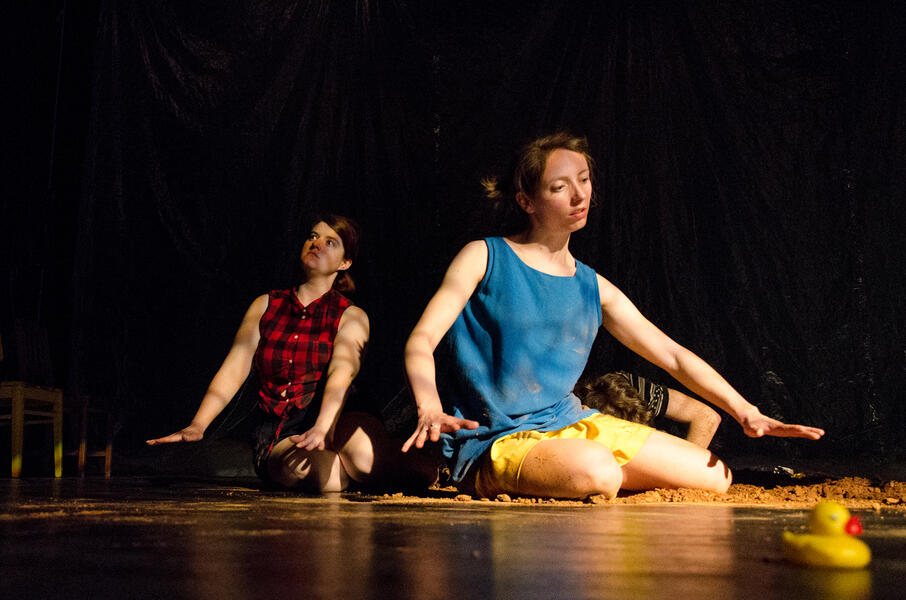 Dream Island (2015) @ Baltimore Theatre Project (MD), Joe's Movement Emporium (DC)In the second part of the performance, we asked the audience to roll their programs and see the site through the holes created by their 'telescopes'. It gave them a choice to see a specific part of the stage as well as a fragmentary view of the bodies, shifting the role of the audience from the bystanders to the participants and the witnesses of the incident. "...their bodies become possessed with alien forces, pushing them into spastic contortions and floating states of paralysis. They perform movements there aren't words for. - Baltimore City Paper
Dream Island (2015) @ Baltimore Theatre Project (MD), Joe's Movement Emporium (DC)In the second part of the performance, we asked the audience to roll their programs and see the site through the holes created by their 'telescopes'. It gave them a choice to see a specific part of the stage as well as a fragmentary view of the bodies, shifting the role of the audience from the bystanders to the participants and the witnesses of the incident. "...their bodies become possessed with alien forces, pushing them into spastic contortions and floating states of paralysis. They perform movements there aren't words for. - Baltimore City Paper -
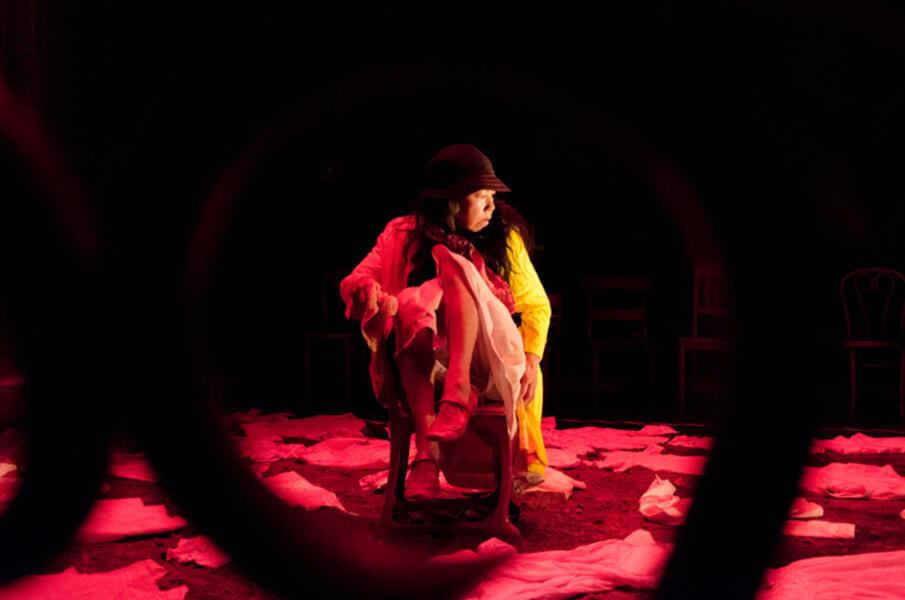 Dream Island (2015) @ Baltimore Theatre Project (MD), Joe's Movement Emporium (DC)"Be sure to not blink when Naoko Maeshiba is on the stage. Her Noh honed movements tie bold and brash with subtle and genuine and won’t let go. Her face is a living mask like that espoused by Jerzy Grotowski. She melds and shapes raw emotion into every eye flick, finger turn, and heel lift." - Theatre Bloom
Dream Island (2015) @ Baltimore Theatre Project (MD), Joe's Movement Emporium (DC)"Be sure to not blink when Naoko Maeshiba is on the stage. Her Noh honed movements tie bold and brash with subtle and genuine and won’t let go. Her face is a living mask like that espoused by Jerzy Grotowski. She melds and shapes raw emotion into every eye flick, finger turn, and heel lift." - Theatre Bloom -
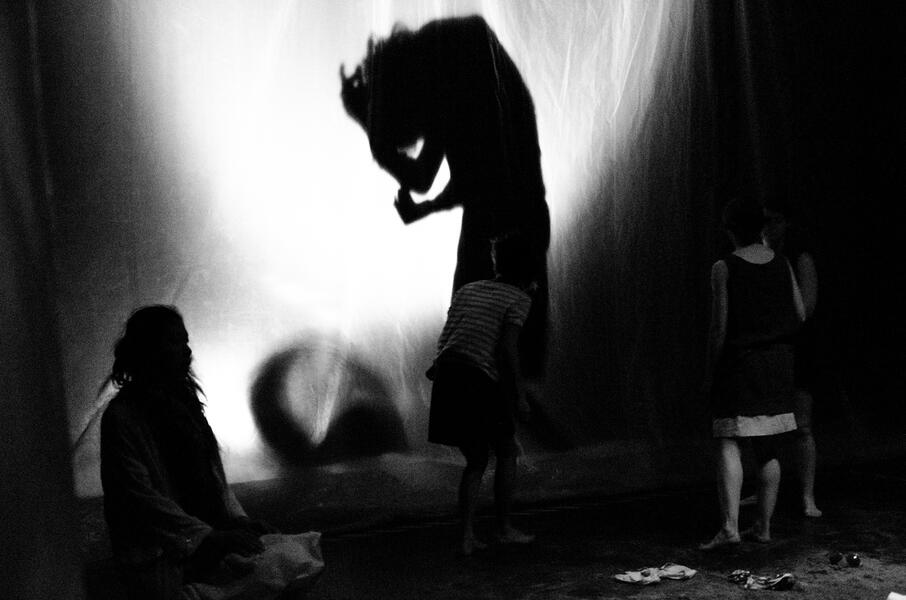 Dream Island (2015) @ Baltimore Theatre Project (MD), Joe's Movement Emporium (DC)The dialogue between the shadow and the light through different materials give me a rich pallet of language to work with. The translucent nature of this plastic made it possible to have a wide range of gradations and visibility. "This hypnotic and jarring performance, invites you to shatter your vision of what performance ought to be." - Theatre Bloom "Without consistently coherent dialogue or a clear action-driven plot, the sensory experience alone grounds the performance in a powerful but subtle narrative... Watching the performance unfold is like watching an action painter begin to construct an image before going over it or erasing over and over again, leaving remnants of what came before." -Baltimore City Paper, "From tropical dreamscape to trash dump to nuclear dystopia to plastic tsunami, the scene evolves as a surreal and at times absurdist painting of a real place that feels like a microcosm for the real world" - Baltimore City Paper
Dream Island (2015) @ Baltimore Theatre Project (MD), Joe's Movement Emporium (DC)The dialogue between the shadow and the light through different materials give me a rich pallet of language to work with. The translucent nature of this plastic made it possible to have a wide range of gradations and visibility. "This hypnotic and jarring performance, invites you to shatter your vision of what performance ought to be." - Theatre Bloom "Without consistently coherent dialogue or a clear action-driven plot, the sensory experience alone grounds the performance in a powerful but subtle narrative... Watching the performance unfold is like watching an action painter begin to construct an image before going over it or erasing over and over again, leaving remnants of what came before." -Baltimore City Paper, "From tropical dreamscape to trash dump to nuclear dystopia to plastic tsunami, the scene evolves as a surreal and at times absurdist painting of a real place that feels like a microcosm for the real world" - Baltimore City Paper -
 Dream Island (2015) @ Baltimore Theatre Project (MD), Joe's Movement Emporium (DC)We used the cinematic techniques such as 'cut', 'cross-fade', 'framing', and 'focal shift' in order to make the scene break blurry. This device gave the audience freedom to create and edit their own versions of "Dream Island" as they went along. "...an obsessional park where dreams are shredded and collaged together in a papier-mãchè sculpture of light, movement, and sound." - Theatre Bloom
Dream Island (2015) @ Baltimore Theatre Project (MD), Joe's Movement Emporium (DC)We used the cinematic techniques such as 'cut', 'cross-fade', 'framing', and 'focal shift' in order to make the scene break blurry. This device gave the audience freedom to create and edit their own versions of "Dream Island" as they went along. "...an obsessional park where dreams are shredded and collaged together in a papier-mãchè sculpture of light, movement, and sound." - Theatre Bloom -
What we see why we see (2012)@Dance Place, Washington, D.C. - direction/choreography/sound, costume, environment design/performance with Tzveta KassabovaMemories and perceptions are strange things. We choose to see and memorize certain things, not others. A Bulgarian choreographer, Tzveta Kassabova, and I experimented with the visual perception. Plastic sheets and bags of different sizes were used as the source material to generate the context and the movements from. Actions happened behind, under, and around them, constraining the visual information audience received. "... two artists have a lot in common. Strong, original movers who fully inhabit the space they’re in, both are foreign-born—Kassabova hails from Bulgaria, while Maeshiba is from Japan— and bring a seriousness to their movement exploration that feels, to me at least, almost un-American in its rigor...Be ready for some ambiguity: while the environment has been intentionally set by the artists, each audience member’s take on the performance will likely be a bit of an individual journey." - Washington City Paper
-
 What we see why we see (2012)@Dance Place, Washington, D.C."Her performance today evoked many images for me from my memories, seeing only partly what's going on, the ocean, the dessert, old photos, seeing through a glass darkly, partly there, connections, missed connections, connections in the midst of loneliness."- Nancy Havlik
What we see why we see (2012)@Dance Place, Washington, D.C."Her performance today evoked many images for me from my memories, seeing only partly what's going on, the ocean, the dessert, old photos, seeing through a glass darkly, partly there, connections, missed connections, connections in the midst of loneliness."- Nancy Havlik -
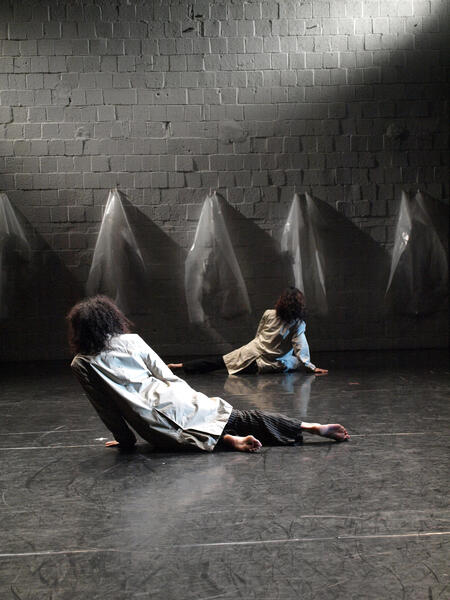 What we see why we see (2012)@Dance Place, Washington, D.C."...moments that are revelatory, but fleeting and more occasional than most people would like to admit. I like immensely that you created those moments-where we could see you and you us-clearly in a staged performance where the stage was an environment that seemed to me to represent the shadowy nature of our awareness of the objects and people in our everyday lives." - Dan Eades , "... I suspect that the performance itself is sort of a glass. With the audience seeing the performance through the glass (or lens) of their immediate awareness (or lack thereof) and minds and histories and experiences and the performers presenting themselves through their performance amidst staging that serves as almost a camouflage of their movement and their selves. But that camouflage serves to highlight moments of connection. And to remind everyone of the value of those moments, the moments, perhaps, we live for. " - Dan Eades
What we see why we see (2012)@Dance Place, Washington, D.C."...moments that are revelatory, but fleeting and more occasional than most people would like to admit. I like immensely that you created those moments-where we could see you and you us-clearly in a staged performance where the stage was an environment that seemed to me to represent the shadowy nature of our awareness of the objects and people in our everyday lives." - Dan Eades , "... I suspect that the performance itself is sort of a glass. With the audience seeing the performance through the glass (or lens) of their immediate awareness (or lack thereof) and minds and histories and experiences and the performers presenting themselves through their performance amidst staging that serves as almost a camouflage of their movement and their selves. But that camouflage serves to highlight moments of connection. And to remind everyone of the value of those moments, the moments, perhaps, we live for. " - Dan Eades -
 What we see why we see (2012)@Dance Place, Washington, D.C."Maeshiba's movements are so exact, so precise, it is difficult not to watch her closely. And her intelligence and restrained emotion radiates an awareness that seems charged with meaning." - Dan Eades
What we see why we see (2012)@Dance Place, Washington, D.C."Maeshiba's movements are so exact, so precise, it is difficult not to watch her closely. And her intelligence and restrained emotion radiates an awareness that seems charged with meaning." - Dan Eades
Intimating INFINITY: Face of Another (2010)/Scent of Sky (2009)
Space, infinity, gravity, mortality, and the edge of my body - these were the words popping up in my mind as I worked with these two pieces. With my shoulder injuries then, I was facing the limitation of my body and trying to figure out how to move by yielding, not by forcing. Working with the space above and around me and manipulating light helped me tremendously in tackling with this challenge and entering into a new realm of experience.
********************************************************************************************
FACE OF ANOTHER (2010)
Concept, choreography, direction, environment/costume design, and performance
A sense of displacement and search for eternity in nothingness. Fluctuating on the boundary between reality and illusion, the familiar and the unknown, the past and the present, and life and death, the delicate balance tips and breaks into each other, revealing the origin of loneliness, desire, and fear in her body.
Material: Magic mirror made of plexiglass, white powder, water
April 2010 @ Dance Place, Washington, DC
**********************************************
SCENT OF SKY (2009)
Choreography,environment design, and performance
Duo with a sound artist, Alberto Gaitan. Exploration of the infinity of the unknown in science/technology.
My character transformed physically and mentally through the use of mini LED lights attached inside of my coat, computer-generated sound bites, falling ping pong balls, and time-based video image slowly unfolding onto my body.
Sound/music by Alberto Gaiman
Material: white ping pong balls, LED lights
June 2009, @ Source Theatre, Washington, DC (Source Theatre Festival Mash-up series)
********************************************************************************************
FACE OF ANOTHER (2010)
Concept, choreography, direction, environment/costume design, and performance
A sense of displacement and search for eternity in nothingness. Fluctuating on the boundary between reality and illusion, the familiar and the unknown, the past and the present, and life and death, the delicate balance tips and breaks into each other, revealing the origin of loneliness, desire, and fear in her body.
Material: Magic mirror made of plexiglass, white powder, water
April 2010 @ Dance Place, Washington, DC
**********************************************
SCENT OF SKY (2009)
Choreography,environment design, and performance
Duo with a sound artist, Alberto Gaitan. Exploration of the infinity of the unknown in science/technology.
My character transformed physically and mentally through the use of mini LED lights attached inside of my coat, computer-generated sound bites, falling ping pong balls, and time-based video image slowly unfolding onto my body.
Sound/music by Alberto Gaiman
Material: white ping pong balls, LED lights
June 2009, @ Source Theatre, Washington, DC (Source Theatre Festival Mash-up series)
-
Face of Another (2010) @ Dance Place, Washington, D.C. - concept/direction/choreography/environment, costume, sound design/performanceA sense of displacement and search for eternity in nothingness. Fluctuating on the boundary between reality and illusion, the familiar and the unknown, the past and the present, and life and death, the delicate balance tips and breaks into each other, revealing the origin of loneliness, desire, and fear in her body. Time and space stretches horizontally and vertically in this piece. Various time and place visits her as she stands in void. "It's the kind of work that is so well-paced and so carefully crafted that the audience can comfortably get lost in it, completely entranced by the strange world she has created." – The Washington Post
-
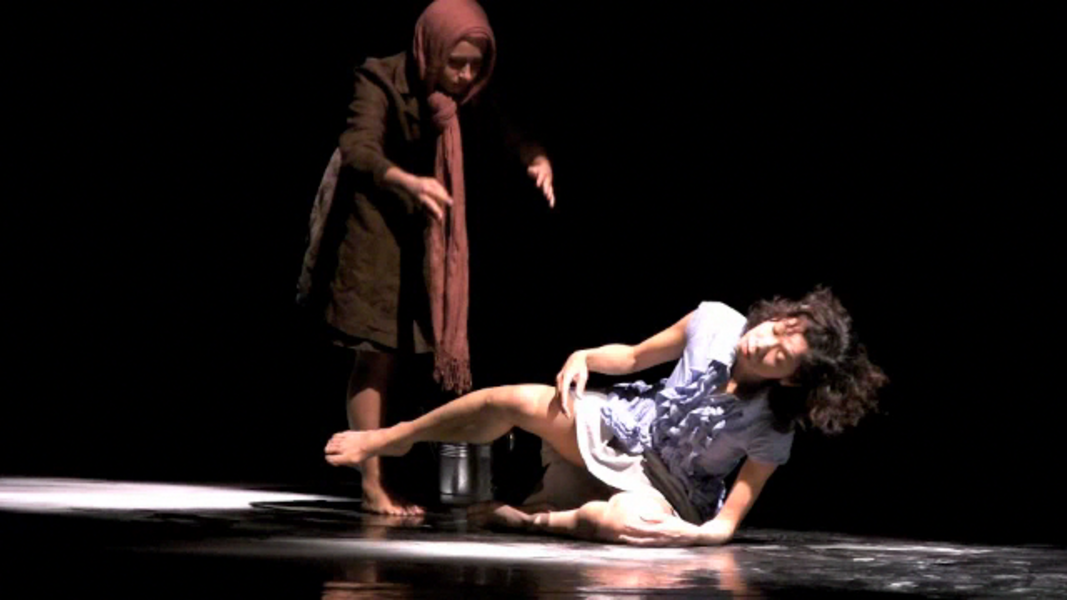 Face of Another (2010) @ Dance Place, Washington, D.C.Another element used in the piece was water. Towards the end of the performance, a girl approaches me and pours water onto my body from a small watering can. The sense of wet material on my skin evoked various emotions and sensations that formed my movements.
Face of Another (2010) @ Dance Place, Washington, D.C.Another element used in the piece was water. Towards the end of the performance, a girl approaches me and pours water onto my body from a small watering can. The sense of wet material on my skin evoked various emotions and sensations that formed my movements. -
 Face of Another (2010) @ Dance Place, Washington, D.C.'‘Face of Another’shows how smart and thorough a choreographer Maeshiba is, as it has no linear narrative and yet somehow builds to a riveting climax." - The Washington Post
Face of Another (2010) @ Dance Place, Washington, D.C.'‘Face of Another’shows how smart and thorough a choreographer Maeshiba is, as it has no linear narrative and yet somehow builds to a riveting climax." - The Washington Post -
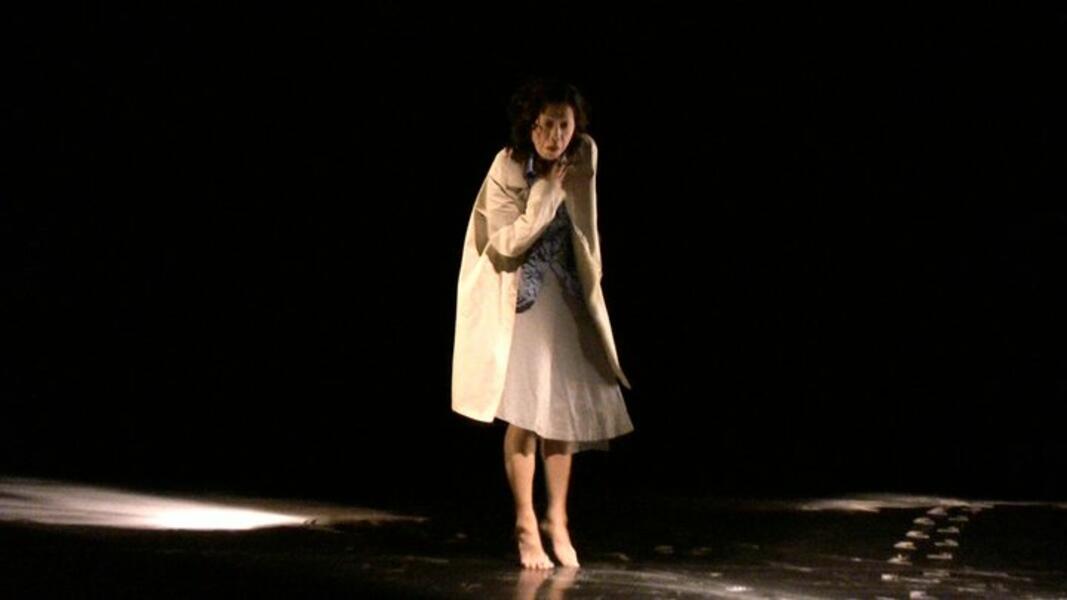 Face of Another (2010) @ Dance Place, Washington, D.C."Through a collage of fluid gesture and intentionally unsteady hobbling, Maeshiba takes a journey to make sense of herself and her place in the world." - The Washington Post
Face of Another (2010) @ Dance Place, Washington, D.C."Through a collage of fluid gesture and intentionally unsteady hobbling, Maeshiba takes a journey to make sense of herself and her place in the world." - The Washington Post -
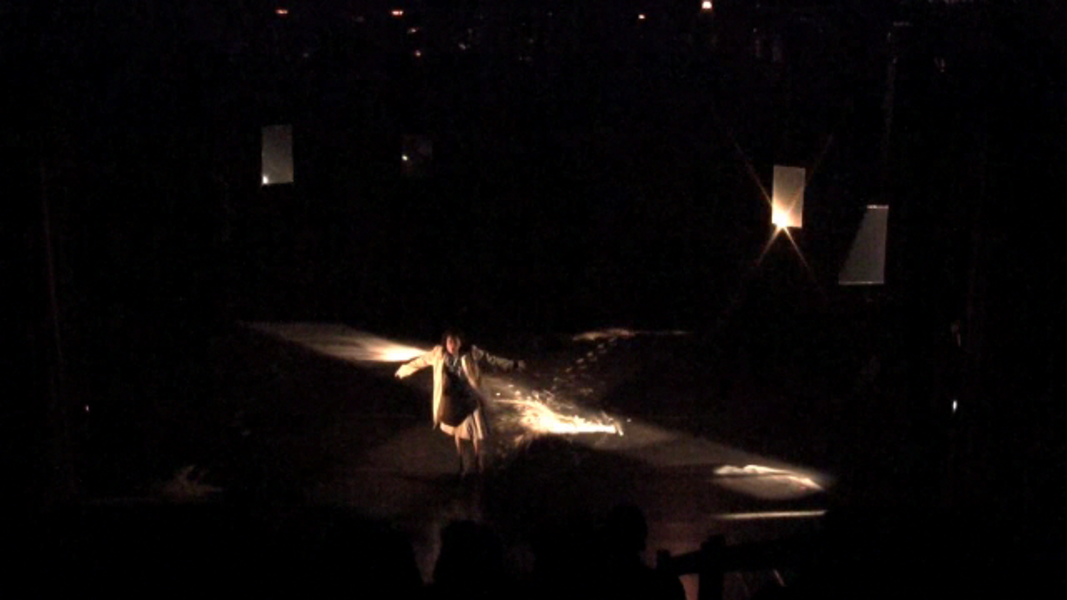 Face of Another (2010) @ Dance Place, Washington, D.C.I hang eight magic mirrors (reflective surface made with window film and plexiglass) in the air and placed white powder on the floor. I was curious to see how the powder tracks my footprints as I danced and how the reflections from the magic mirror can be cast in the audience side, blurring the line between the stage and the audience.
Face of Another (2010) @ Dance Place, Washington, D.C.I hang eight magic mirrors (reflective surface made with window film and plexiglass) in the air and placed white powder on the floor. I was curious to see how the powder tracks my footprints as I danced and how the reflections from the magic mirror can be cast in the audience side, blurring the line between the stage and the audience. -
PASSWORD - NaokoM
-
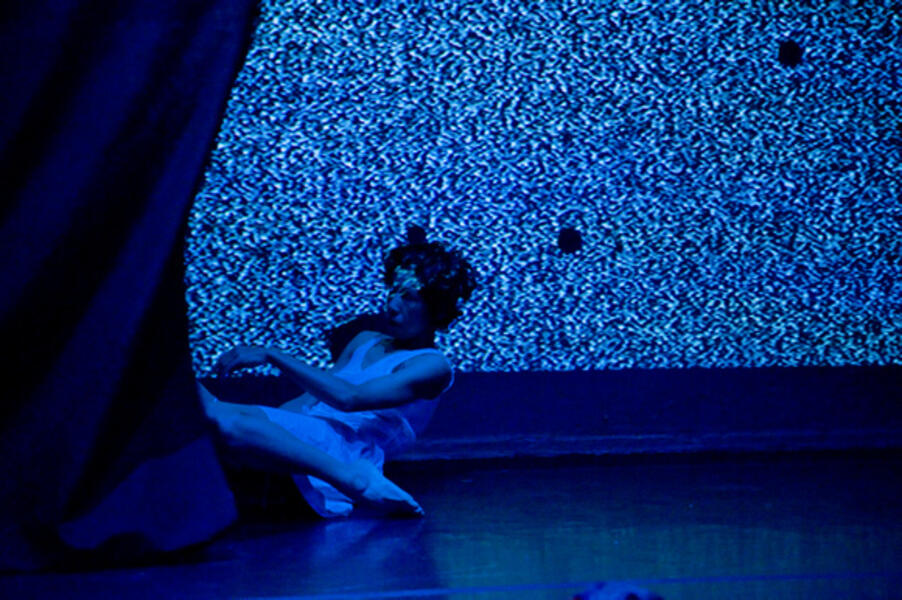 Scent of Sky (2009)@ Source Theatre, Washington, D.C."Her body is so flexible, boneless, and fluid it's as if her limbs are caught in underwater currents…" - DC Theatre Scene
Scent of Sky (2009)@ Source Theatre, Washington, D.C."Her body is so flexible, boneless, and fluid it's as if her limbs are caught in underwater currents…" - DC Theatre Scene -
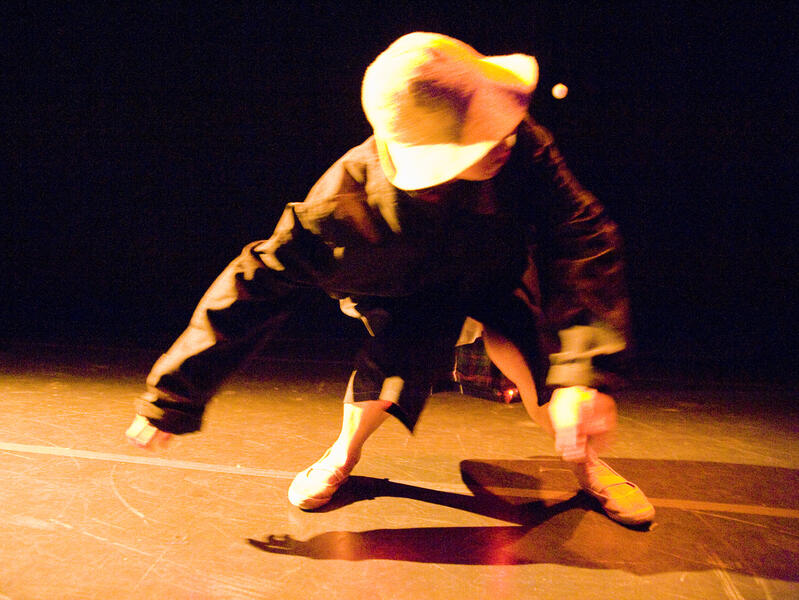 Scent of Sky (2009)@ Source Theatre, Washington, D.C.Tiny LED lights placed inside of my coat are casting red shadow on the ground. The piece started with a complete darkness with these lights illuminating only a small part of my body. My character transformed physically and mentally through the use of the lights, computer-generated sound bites, falling ping pong balls, and time-based video image slowly unfolding onto my body.
Scent of Sky (2009)@ Source Theatre, Washington, D.C.Tiny LED lights placed inside of my coat are casting red shadow on the ground. The piece started with a complete darkness with these lights illuminating only a small part of my body. My character transformed physically and mentally through the use of the lights, computer-generated sound bites, falling ping pong balls, and time-based video image slowly unfolding onto my body. -
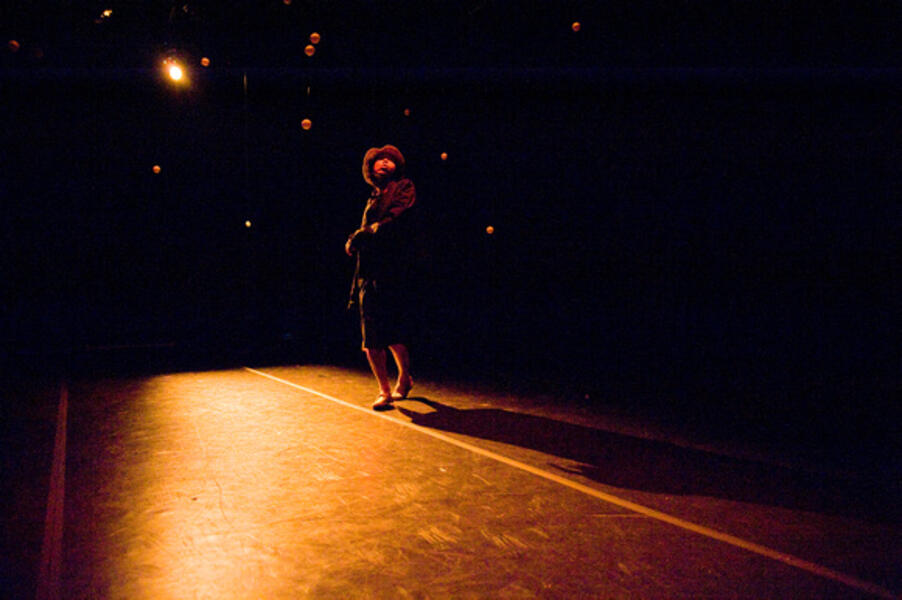 Scent of Sky (2009)@ Source Theatre, Washington, D.C."Dancer/choreographer Naoko Maeshiba and electronic-media artist, Alberto Gaitan explore a realm of sound and kinetic gesture where words are inadequate." - DC Theatre Scene
Scent of Sky (2009)@ Source Theatre, Washington, D.C."Dancer/choreographer Naoko Maeshiba and electronic-media artist, Alberto Gaitan explore a realm of sound and kinetic gesture where words are inadequate." - DC Theatre Scene -
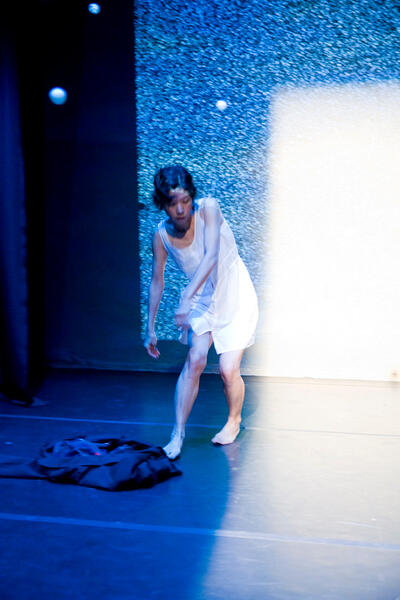 Scent of Sky (2009)@ Source Theatre, Washington, D.C.I have worked with the motif of shedding from 2005 to 2012. In this piece, 'shedding' took a whole different meaning. Instead of being born, I was disappearing into the white particles of the screen behind me. The further I moved forward, the more sucked in I was.
Scent of Sky (2009)@ Source Theatre, Washington, D.C.I have worked with the motif of shedding from 2005 to 2012. In this piece, 'shedding' took a whole different meaning. Instead of being born, I was disappearing into the white particles of the screen behind me. The further I moved forward, the more sucked in I was.
Sense of BELONGING: Remains of Shadow (2005-2007)/Kawatokawa (2012)
These two pieces explored my relationship with Japan and America. My place in this country, what it means to be here, history, personal memories.
This was the first time I consciously and overtly examined my Japanese heritage. I wanted to explore my relationship with Japan and America and how the relationship between two countries has influenced me in my life. History, personal memories, and unresolved conflicts became the driving force of these pieces.
******************************
REMAINS OF SHADOW (2005-2007) - full-length
Conception, direction, choreography, environment/costume/object design, performance
The piece consisted of two parts. First part being the journey of a blue-eyed doll that was sent from America to Japan during WWI as a token of friendship. The second part was about the experience of going through various stages 49 days after death.
Material - translucent cloth, plastic
Lighting design by Sabrina Hamilton (Ko Festival)
Projection design by Chas Marsh
Premiere - Spring 2005 @ Ko Festival of Performance, Amherst, MA, Tour - 2006 Questfest, 2006 Capital Fringe Festval, 2007 Theatre of Yugen
**********************************************************************************
KAWATOKAWA (Skin/River 2012) - full-length
Concept, direction, choreography, environment/object/costume design, and performance
An autobio extravaganza, drawing from my research about “space, body, and language” in Tokyo and Czech Republic.
This full evening piece was a departure from my usual mode of performance. The piece consisted of 12 vignettes based on the memories and the landscapes of my childhood and what could have happened to me if I had lived in Japan. I'm trying to figure out what my Japanese-ness and where I belong. The quick shift from one vignette to another required a comedian/clown’s immediacy and Kabuki actor’s finesse.
Dramaturgy by Juanita Rockwell
Lighting design by Kel Millionaire
May 2012 @ Baltimore Theatre Project
This was the first time I consciously and overtly examined my Japanese heritage. I wanted to explore my relationship with Japan and America and how the relationship between two countries has influenced me in my life. History, personal memories, and unresolved conflicts became the driving force of these pieces.
******************************
REMAINS OF SHADOW (2005-2007) - full-length
Conception, direction, choreography, environment/costume/object design, performance
The piece consisted of two parts. First part being the journey of a blue-eyed doll that was sent from America to Japan during WWI as a token of friendship. The second part was about the experience of going through various stages 49 days after death.
Material - translucent cloth, plastic
Lighting design by Sabrina Hamilton (Ko Festival)
Projection design by Chas Marsh
Premiere - Spring 2005 @ Ko Festival of Performance, Amherst, MA, Tour - 2006 Questfest, 2006 Capital Fringe Festval, 2007 Theatre of Yugen
**********************************************************************************
KAWATOKAWA (Skin/River 2012) - full-length
Concept, direction, choreography, environment/object/costume design, and performance
An autobio extravaganza, drawing from my research about “space, body, and language” in Tokyo and Czech Republic.
This full evening piece was a departure from my usual mode of performance. The piece consisted of 12 vignettes based on the memories and the landscapes of my childhood and what could have happened to me if I had lived in Japan. I'm trying to figure out what my Japanese-ness and where I belong. The quick shift from one vignette to another required a comedian/clown’s immediacy and Kabuki actor’s finesse.
Dramaturgy by Juanita Rockwell
Lighting design by Kel Millionaire
May 2012 @ Baltimore Theatre Project
-
Remains of Shadow (2005-2007) Premiere: Ko Festival of Performance, Amherst, (MA), Tour: Questfest (MD), Capital Fringe Festval (DC), Theatre of Yugen (SF) - concept/direction/choreography/environment, costume, object, sound design/performanceThe piece consisted of two parts. First part being the journey of a blue-eyed doll that was sent from America to Japan in 1927 as a token of friendship, which was burned or destroyed during the WWII. The second part was about the experience of going through the buddhist rebirth cycle of 49 days. This footage features the excerpt from the first part.
-
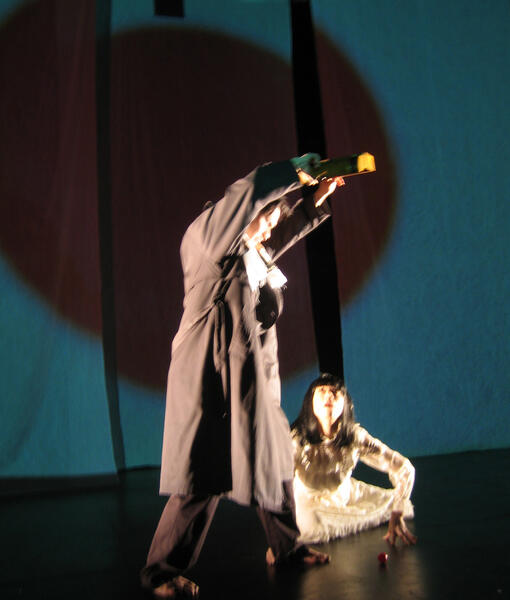 Remains of Shadow (2005-2007) @ Ko Festival of Performance at Amherst, MA“Remains of Shadow probed subtle regions of emotion and memory in the liminal spaces between cultures, countries, and histories…while technology enhanced the production, the virtuosity of performers Maeshiba and Aoyagi proved its centerpiece. Their bodies bear traces of rigorous physical training as well as everyday socialization across cultures.” - Theatre Journal
Remains of Shadow (2005-2007) @ Ko Festival of Performance at Amherst, MA“Remains of Shadow probed subtle regions of emotion and memory in the liminal spaces between cultures, countries, and histories…while technology enhanced the production, the virtuosity of performers Maeshiba and Aoyagi proved its centerpiece. Their bodies bear traces of rigorous physical training as well as everyday socialization across cultures.” - Theatre Journal -
 Remains of Shadow (2005-2007)@ Questfest, MD"...performed with compelling emotion-plausibly and poignantly conveying confusion, anguish, and displacement.” – The Washington Post
Remains of Shadow (2005-2007)@ Questfest, MD"...performed with compelling emotion-plausibly and poignantly conveying confusion, anguish, and displacement.” – The Washington Post -
 Remains of Shadow (2005-2007)@Capital Fringe Festival, DC“In one stunning sequence Maeshiba…delicately crossed toward an offstage light…a subtle tilt of Maeshiba’s head, and her straw hat fell to the ground, evoking the sudden transportation of thousands of souls into their next journey on 6 August 1945.” - Theatre Journal
Remains of Shadow (2005-2007)@Capital Fringe Festival, DC“In one stunning sequence Maeshiba…delicately crossed toward an offstage light…a subtle tilt of Maeshiba’s head, and her straw hat fell to the ground, evoking the sudden transportation of thousands of souls into their next journey on 6 August 1945.” - Theatre Journal -
Kawatokawa (Skin/river 2012) @ Baltimore Theatre Project (MD) - concept/direction/choreography/object,costume, sound design/performanceThis full evening piece was a departure from my usual mode of performance in that I played a clownish character who established an intimate relationship with the audience. The piece consisted of 12 vignettes drawing from the memories and the landscapes of my childhood, recent accident in Fukushima, figuring out what my Japanese-ness. The quick shift from one vignette to another required a comedian/clown’s immediacy and Kabuki actor’s finesse.
-
 Kawatokawa (2012)@ Baltimore Theatre Project, MDThe stage environment was created with three chairs, one table, and various objects that have appeared in my previous productions. In a sense, it was like going through an inventory of Naoko both in personal life and artistic creation. "The audience is clearly touched as the piece rises toward its final paroxysm, even if the precise cause of that chiseled touch remains veiled."- Baltimore Theatre Journal
Kawatokawa (2012)@ Baltimore Theatre Project, MDThe stage environment was created with three chairs, one table, and various objects that have appeared in my previous productions. In a sense, it was like going through an inventory of Naoko both in personal life and artistic creation. "The audience is clearly touched as the piece rises toward its final paroxysm, even if the precise cause of that chiseled touch remains veiled."- Baltimore Theatre Journal -
 Kawatokawa (2012)@ Baltimore Theatre Project, MD"Especially striking is the emotive range of Maeshiba's choreography and peformance...the basic emtoions of fear, curiosity, and rejection float off the stage with carefully calibrated movements." - Baltimore Theatre Journal
Kawatokawa (2012)@ Baltimore Theatre Project, MD"Especially striking is the emotive range of Maeshiba's choreography and peformance...the basic emtoions of fear, curiosity, and rejection float off the stage with carefully calibrated movements." - Baltimore Theatre Journal -
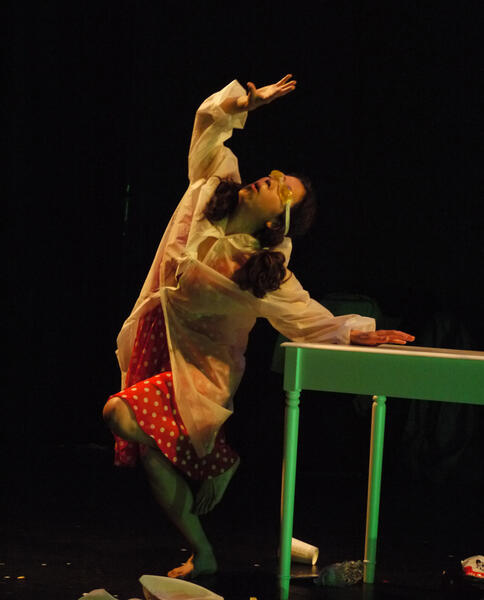 Kawatokawa (2012)@ Baltimore Theatre Project, MDCockroaches are prevalent in Japanese summer. I made a cockroach dance honoring the longevity of this grotesque creature. "Moving from one prop or boldly colored piece of clothing to another, Maeshiba skillfully expresses the passions proper to each stage of transition…Humor and pathos alternate as the life of the often-baffled protagonist unfolds." - Baltimore Theatre Journal
Kawatokawa (2012)@ Baltimore Theatre Project, MDCockroaches are prevalent in Japanese summer. I made a cockroach dance honoring the longevity of this grotesque creature. "Moving from one prop or boldly colored piece of clothing to another, Maeshiba skillfully expresses the passions proper to each stage of transition…Humor and pathos alternate as the life of the often-baffled protagonist unfolds." - Baltimore Theatre Journal -
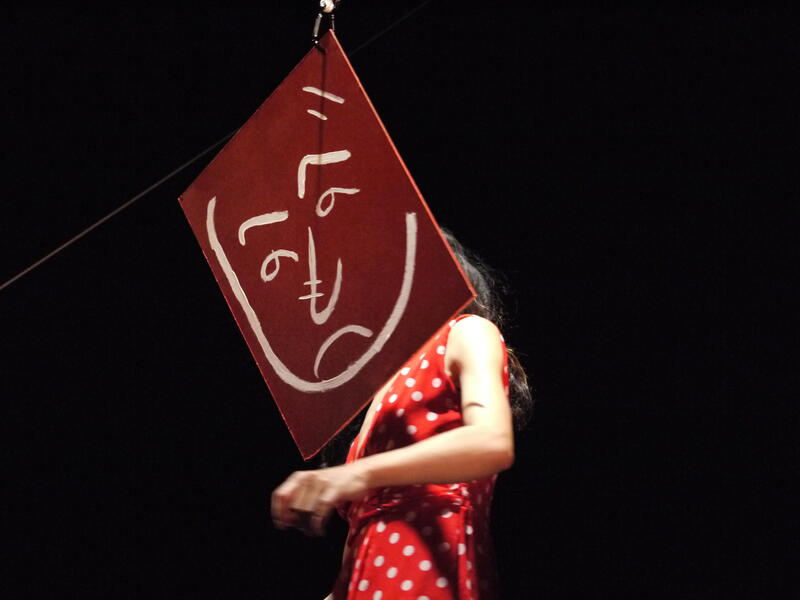 Kawatokawa (2012)@ Baltimore Theatre Project, MDMy face is obliterated by a a face written by Japanese characters. What is written on the other side is the Article 9 of Japanese constitution called 'peace constitution' which outlaws war as a means to settle international disputes involving the state. It went into effect during the American post-war occupation of Japan. There has been a debate whether to alter its constitution by removing Article 9,
Kawatokawa (2012)@ Baltimore Theatre Project, MDMy face is obliterated by a a face written by Japanese characters. What is written on the other side is the Article 9 of Japanese constitution called 'peace constitution' which outlaws war as a means to settle international disputes involving the state. It went into effect during the American post-war occupation of Japan. There has been a debate whether to alter its constitution by removing Article 9,
Entering the LIMINAL: Trace (2004)/Twilight Station (2014)
The word ‘liminal’ feels light, mysterious, and indispensable. It evokes the beginning of a process and also something on the edge anticipating a big shift. These two pieces attempt to capture this potent moment.
*********************************************************************************************
TRACE (2004) - full-length
Concept, choreography, direction, environment design, sound design, and performance
This Kennedy Center commissioned piece allowed me to work with a videographer, Chas Marsh, Audrey Chen as a musician, and Jacki Milad's drawing as animation. With these added visual/auditory elements, I experimented expanding the mise-en-sene into the 3D realm.
"Trace" examines the state of displacement through the trace within one's body and mind as well as in the society. Six individual segments treat various states of collision such as the the nature vs. the technology, the disposable culture vs. the longing for the spirituality, and tradition vs. freedom. Trace is multi-disciplinary in its nature, combining movements with live voice and cello by Audrey Chen, the video images by Chas Marsh, and the animation by Jackie Milad and Dan Breen. Costume by Jenifer Alonzo, Lighting design by Cathy Eliot.
Material - white scrim, cheese cloth masks, newspaper
Lighting design by Cathy Eliott
Costume design by Jenifer Alonzo
Video design by Chas Marsh
Animation Design by Jackie Milad, Dan Breen
Commissioned by Kennedy Center Local Dance Commissioning Project
Received 'Excellence in Sound Design' by Metro DC Dance Award, nominated for 'Outstanding Overall Production', 'Outstanding New Work', and 'Outstanding Individual Performance'.
May 2004 @ Kennedy Center Millennium Stage
*************************************************
TWILIGHT STATION (2014) - full-length
Concept, direction, choreography, environment/costume/object design
Twilight station was commissioned by Quest International visual theatre. I worked with three performers. One of them was deaf, another bilingual (sign and English), and the other was an English speaker. We used the first month to train physically and vocally together and explored the shared language among the four of us. Through personal exploration, performers gradually formed three different stories. Twilight Station follows the journey of three people who meet in an obscure station, a juncture of arrivals and departures. Traveling through the multi-layered time and space in their pursuit of missing self, they encounter with each other repeatedly in different dimensions where their past lives, dreams, and illusions get revealed and intertwined. The piece was structured in three parts: Part I - still life/present, Part II - portrait/dream, and Part III - landscape/collective unconscious.
Material - screen door sheet, metal curtain rods, cheese cloth, red sand
Lighting design by Sarah Thunderman
Music by Andy Hayleck
March 2014 @ Baltimore Theatre Project (Quest International Visual Theatre Festival)
*********************************************************************************************
TRACE (2004) - full-length
Concept, choreography, direction, environment design, sound design, and performance
This Kennedy Center commissioned piece allowed me to work with a videographer, Chas Marsh, Audrey Chen as a musician, and Jacki Milad's drawing as animation. With these added visual/auditory elements, I experimented expanding the mise-en-sene into the 3D realm.
"Trace" examines the state of displacement through the trace within one's body and mind as well as in the society. Six individual segments treat various states of collision such as the the nature vs. the technology, the disposable culture vs. the longing for the spirituality, and tradition vs. freedom. Trace is multi-disciplinary in its nature, combining movements with live voice and cello by Audrey Chen, the video images by Chas Marsh, and the animation by Jackie Milad and Dan Breen. Costume by Jenifer Alonzo, Lighting design by Cathy Eliot.
Material - white scrim, cheese cloth masks, newspaper
Lighting design by Cathy Eliott
Costume design by Jenifer Alonzo
Video design by Chas Marsh
Animation Design by Jackie Milad, Dan Breen
Commissioned by Kennedy Center Local Dance Commissioning Project
Received 'Excellence in Sound Design' by Metro DC Dance Award, nominated for 'Outstanding Overall Production', 'Outstanding New Work', and 'Outstanding Individual Performance'.
May 2004 @ Kennedy Center Millennium Stage
*************************************************
TWILIGHT STATION (2014) - full-length
Concept, direction, choreography, environment/costume/object design
Twilight station was commissioned by Quest International visual theatre. I worked with three performers. One of them was deaf, another bilingual (sign and English), and the other was an English speaker. We used the first month to train physically and vocally together and explored the shared language among the four of us. Through personal exploration, performers gradually formed three different stories. Twilight Station follows the journey of three people who meet in an obscure station, a juncture of arrivals and departures. Traveling through the multi-layered time and space in their pursuit of missing self, they encounter with each other repeatedly in different dimensions where their past lives, dreams, and illusions get revealed and intertwined. The piece was structured in three parts: Part I - still life/present, Part II - portrait/dream, and Part III - landscape/collective unconscious.
Material - screen door sheet, metal curtain rods, cheese cloth, red sand
Lighting design by Sarah Thunderman
Music by Andy Hayleck
March 2014 @ Baltimore Theatre Project (Quest International Visual Theatre Festival)
-
TRACE (2004) - 'Maeshiba made striking pictures..' - The Washington Post - Premiere @ Kennedy Center Millennium Stage (DC), Tour @ Dance Place (DC)- concept/direction/choreography/environment and sound design/performance"Trace" examines the state of displacement through the trace within one's body and mind as well as in the society. Six individual segments treat various states of collision such as the the nature vs. the technology, the disposable culture vs. the longing for the spirituality, and tradition vs. freedom. Trace is multi-disciplinary in its nature, combining movements with live voice and cello by Audrey Chen, the video images by Chas Marsh, and the animation by Jackie Milad and Dan Breen. Costume by Jenifer Alonzo, Lighting design by Cathy Eliot.
-
 Trace (2004) @ Kennedy Center Millennium Stage, Washington, D.C.Life in costume is intriguing to me. I often feel that it is literally my second skin. When I get to know its nature and behavior, it starts forming into all kinds of shapes to voice its own life./Metro DC Dance Award nomination for outstanding individual performance.
Trace (2004) @ Kennedy Center Millennium Stage, Washington, D.C.Life in costume is intriguing to me. I often feel that it is literally my second skin. When I get to know its nature and behavior, it starts forming into all kinds of shapes to voice its own life./Metro DC Dance Award nomination for outstanding individual performance. -
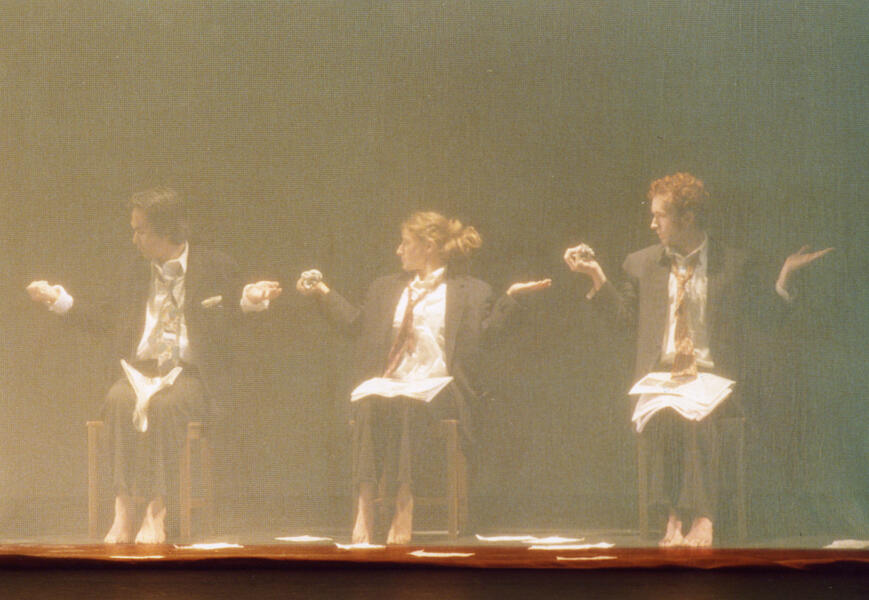 Trace (2004) @ Kennedy Center Millennium Stage, Washington, D.C.Business people are the characters that had often appeared in my earlier works. We used newspaper as a hand object here. They perform a short 'newspaper' dance before shredding it into pieces as they shredded themselves into fragments.
Trace (2004) @ Kennedy Center Millennium Stage, Washington, D.C.Business people are the characters that had often appeared in my earlier works. We used newspaper as a hand object here. They perform a short 'newspaper' dance before shredding it into pieces as they shredded themselves into fragments. -
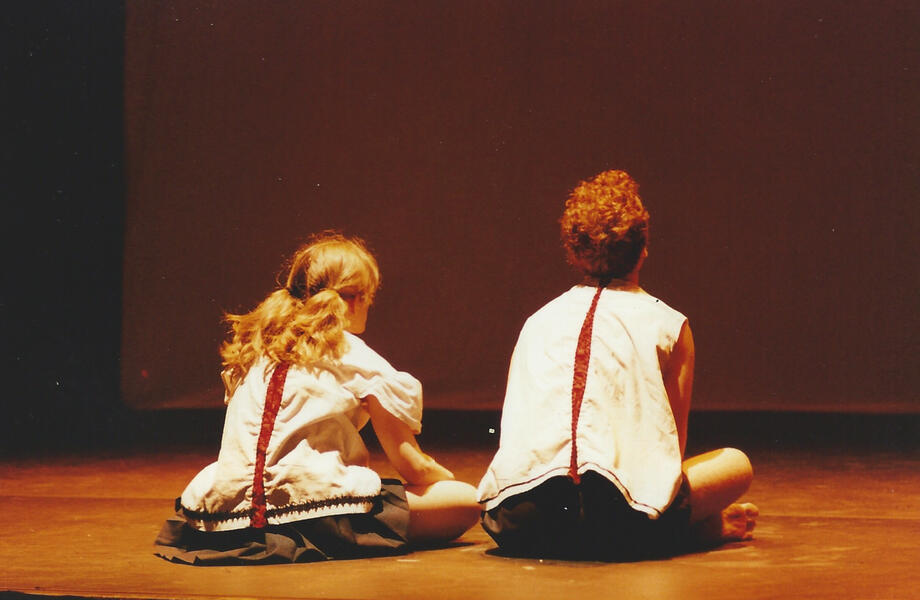 Trace (2004) @ Kennedy Center Millennium Stage, Washington, D.C."Maeshiba made a grand stab at the topic of displacement...through an accumulation of dance, video and live music that gave a sense of fragmentation." - The Washington Post
Trace (2004) @ Kennedy Center Millennium Stage, Washington, D.C."Maeshiba made a grand stab at the topic of displacement...through an accumulation of dance, video and live music that gave a sense of fragmentation." - The Washington Post -
 Trace (2004) @ Kennedy Center Millennium Stage, Washington, D.C.The relationship between the projection and the live body is always a challenge. "Trace" was the first work that I incorporated projection. I was looking to see if the performer himself can shift this relationship with the projection. Initially a merely a background landscape turns into a force and substance that takes over his whole being./ Metro DC Dance Award nomination for outstanding new work and outstanding overall production.
Trace (2004) @ Kennedy Center Millennium Stage, Washington, D.C.The relationship between the projection and the live body is always a challenge. "Trace" was the first work that I incorporated projection. I was looking to see if the performer himself can shift this relationship with the projection. Initially a merely a background landscape turns into a force and substance that takes over his whole being./ Metro DC Dance Award nomination for outstanding new work and outstanding overall production. -
Twilight Station (2014) - developed for Quest international visual theatre festival - @ Baltimore Theatre Project (MD) - concept/direction/choreography/environment, object, and costume designTwilight Station follows the journey of three people who meet in an obscure station, a juncture of arrivals and departures. Traveling through the multi-layered time and space in their pursuit of lost selves, they encounter with each other repeatedly in different dimensions where their past lives, dreams, and illusions get revealed and intertwined. I was drawn to the works of a Japanese film director, Seijun Suzuki, whose work is known for the frequent use of implied moments. Actors make eye contacts. There’s an implication that something is going to happen, but nothing does, which creates the tension/release and unexpected timings. Twilight is an ephemeral, in-between time for these minuscule moments to happen and cause quiet ripples which explode into significant moments years later.
-
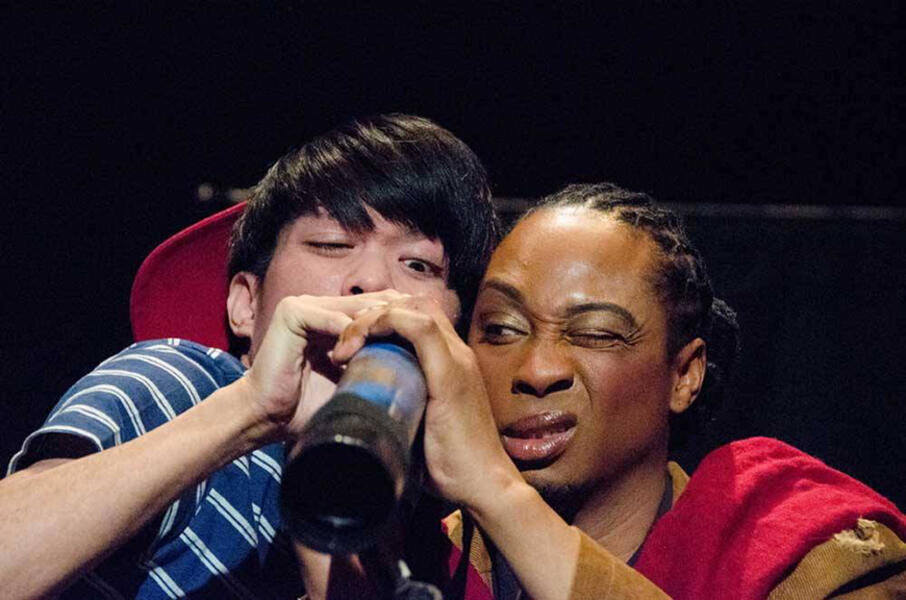 Twilight Station (2014) @ Baltimore Theatre Project, MD"NM: I think anything that’s not based on the clear-cut narrative would ask more from its audiences. I think the challenging part is that it asks for a very serious encounter between the performers and the audience. The performer is communicating with the audience in a specific way through a language that doesn’t have a name. The audience has to allow that to reach the inside of them. It is a self-reflective journey. A joyful one, I hope." - An interview with Maryland State Arts Council Elevator chat
Twilight Station (2014) @ Baltimore Theatre Project, MD"NM: I think anything that’s not based on the clear-cut narrative would ask more from its audiences. I think the challenging part is that it asks for a very serious encounter between the performers and the audience. The performer is communicating with the audience in a specific way through a language that doesn’t have a name. The audience has to allow that to reach the inside of them. It is a self-reflective journey. A joyful one, I hope." - An interview with Maryland State Arts Council Elevator chat -
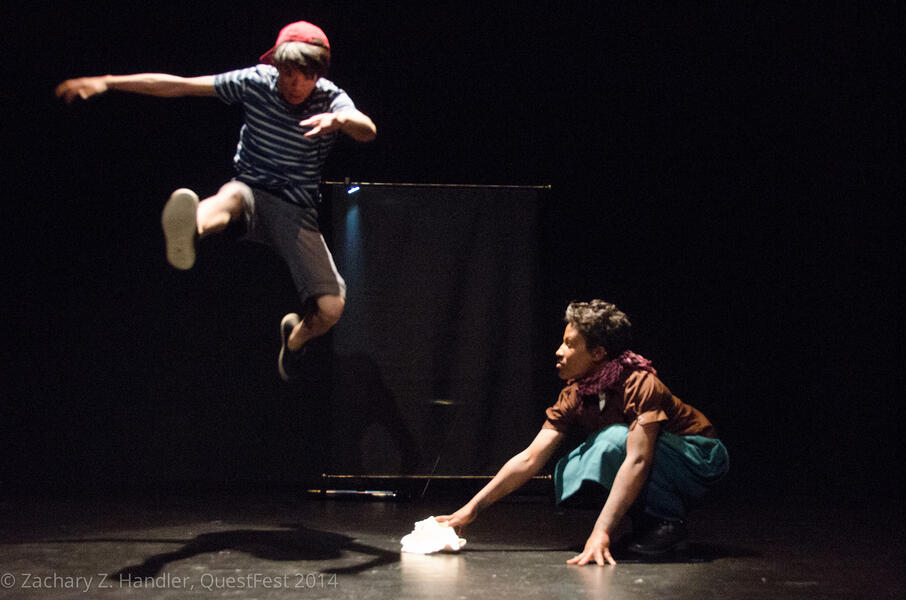 Twilight Station (2014) @ Baltimore Theatre Project, MD"The practically bare stage and little to no props gives away to an organic feel that emphasize the actions of each performer and you are really able to focus on the actors instead of the stage or props...The choreography was enthralling as it lacked traditional movements or dance techniques, but it made each scene more interesting as you recognize how unconventional the play really is. Each character seemed to exhibit an internal conflict or self-discovery that seemed like it could only be seen in their dance movements." - MD Theatre Guide
Twilight Station (2014) @ Baltimore Theatre Project, MD"The practically bare stage and little to no props gives away to an organic feel that emphasize the actions of each performer and you are really able to focus on the actors instead of the stage or props...The choreography was enthralling as it lacked traditional movements or dance techniques, but it made each scene more interesting as you recognize how unconventional the play really is. Each character seemed to exhibit an internal conflict or self-discovery that seemed like it could only be seen in their dance movements." - MD Theatre Guide -
 Twilight Station (2014) @ Baltimore Theatre Project, MD"Director, choreographer and scenographer Naoko Maeshiba created a piece induced with a whirlwind of emotions and characters that are both thought provoking and rare. With only three performers on stage you are able to fully get involved in each character’s personal story. Their stories are made even more powerful by the fact that they completely perform in silence. …anyone who’s open to an innovative and original performance will definitely appreciate ‘Twilight Station.’" - MD Theatre Guide
Twilight Station (2014) @ Baltimore Theatre Project, MD"Director, choreographer and scenographer Naoko Maeshiba created a piece induced with a whirlwind of emotions and characters that are both thought provoking and rare. With only three performers on stage you are able to fully get involved in each character’s personal story. Their stories are made even more powerful by the fact that they completely perform in silence. …anyone who’s open to an innovative and original performance will definitely appreciate ‘Twilight Station.’" - MD Theatre Guide
Moving through the PASSAGES: The Voyage (2004)/Communitas (2002)
My earlier works placed weight on the idea of going through passages - traveling through time and space to appear on the other side having been transformed. Also, these two pieces were performed by the members of Naoko Maeshiba Performance Collective.
************************************************
COMMUNITAS (2002) - full-length
Concept, direction, choreography, environment/object design, and performance
Inspired by Victor Turner's concept of 'Communitas', the piece taps into the uncertainty of our beings through the issues that vex today's world, such as unbalanced resources, youth violence, and aging.
In the landscape of destruction, people wander about searching for a connection: with people, places, and the past. Through images of death and birth in nature, the piece illuminates the human figures which long for love, hope, and beauty, asking the ultimate question: "where are we going?"
Funded by the D.C. Commissions on Arts and Humanities.
Lighting design by Scott Rothenseld
Sound Design by Lukas Zarwell
Song Composition by Sarah Sathya
***********************************************
THE VOYAGE (2004) - full-length
Concept, direction, choreography, environment/object design, and performance
The piece consists of five stories about the voyage captured at the points of departures and arrivals. Intricate human relationships, our conflicted existence. The journey between life and death is vividly depicted through layers of images in the evocative visual poetry.
Costume design by Meredith Wallace
Lighting Design by Mark Fink
Music Composition by Jason Sloan
Sound Design by Gabriel Walker
June 2004 @ Baltimore Theatre Project
************************************************
COMMUNITAS (2002) - full-length
Concept, direction, choreography, environment/object design, and performance
Inspired by Victor Turner's concept of 'Communitas', the piece taps into the uncertainty of our beings through the issues that vex today's world, such as unbalanced resources, youth violence, and aging.
In the landscape of destruction, people wander about searching for a connection: with people, places, and the past. Through images of death and birth in nature, the piece illuminates the human figures which long for love, hope, and beauty, asking the ultimate question: "where are we going?"
Funded by the D.C. Commissions on Arts and Humanities.
Lighting design by Scott Rothenseld
Sound Design by Lukas Zarwell
Song Composition by Sarah Sathya
***********************************************
THE VOYAGE (2004) - full-length
Concept, direction, choreography, environment/object design, and performance
The piece consists of five stories about the voyage captured at the points of departures and arrivals. Intricate human relationships, our conflicted existence. The journey between life and death is vividly depicted through layers of images in the evocative visual poetry.
Costume design by Meredith Wallace
Lighting Design by Mark Fink
Music Composition by Jason Sloan
Sound Design by Gabriel Walker
June 2004 @ Baltimore Theatre Project
-
Communitas (2002-2003) - Premiere @ Kennedy Center Millennium Stage (DC), Tour @ Hirschhorn Museum and Sculpture Garden (DC), Baltimore Theatre Project (MD), Towson University (MD) - concept/direction/choreography/environment design/performanceInspired by Victor Turner's concept of 'Communitas', the piece taps into the uncertainty of our beings through the issues that vex today's world, such as unbalanced resources, youth violence, and aging. Through images of death and birth in nature, the piece illuminates the human figures which long for love, hope, and beauty, asking the ultimate question: "where are we going?" This piece was performed at three different locations: Kennedy Center Millennium Stage, Hirshhorn Museum of the Smithsonian Institute, & Baltimore Theatre Project. This video features the footage from the premiere performance at the Kennedy Center Millennium Stage in 2002.
-
 Communitas (2002-2003)@ Hirshhorn Museum and Sculpture Garden, Washington, D.C.Three women dance the joy of spring. Sensual, ephemeral, and fleeting.
Communitas (2002-2003)@ Hirshhorn Museum and Sculpture Garden, Washington, D.C.Three women dance the joy of spring. Sensual, ephemeral, and fleeting. -
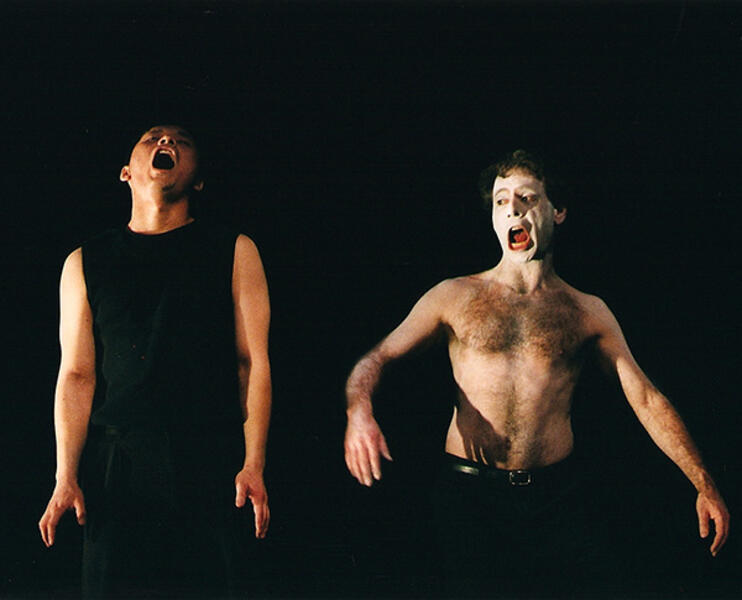 Communitas (2002-2003)@ Baltimore Theatre Project, MDA juvenile delinquent tries to escape from the hands of the controlling force. He is resourceful and uses all means to trick the law enforcement.
Communitas (2002-2003)@ Baltimore Theatre Project, MDA juvenile delinquent tries to escape from the hands of the controlling force. He is resourceful and uses all means to trick the law enforcement. -
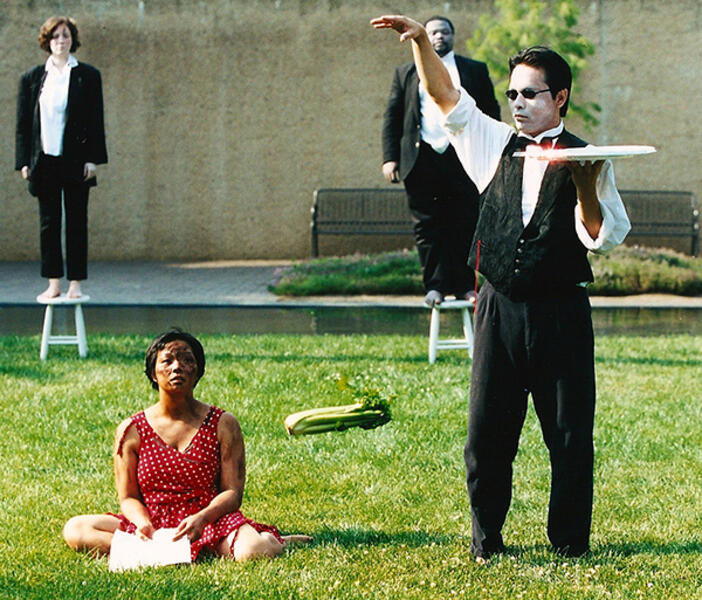 Communitas (2002-2003)@ Hirshhorn Museum and Sculpture Garden, Washington, D.C."I think my methodology is….[laughs] no methodology.I want to keep breaking the rules." - DCTheatre Scene interview: Dancing on the edge of theatre
Communitas (2002-2003)@ Hirshhorn Museum and Sculpture Garden, Washington, D.C."I think my methodology is….[laughs] no methodology.I want to keep breaking the rules." - DCTheatre Scene interview: Dancing on the edge of theatre -
 Communitas (2002-2003)@ Kennedy Center Millennium Stage, Washington, D.C.The idea of reincarnation fascinates me. We are born, and reborn, again and again. This young woman’s journey and mine progressed separately, maintaining the tight connection until we finally meet to discover that we are one.
Communitas (2002-2003)@ Kennedy Center Millennium Stage, Washington, D.C.The idea of reincarnation fascinates me. We are born, and reborn, again and again. This young woman’s journey and mine progressed separately, maintaining the tight connection until we finally meet to discover that we are one. -
The Voyage (2004) @ Baltimore Theatre Project (MD) - concept/direction/choreography/sound design/performance"With few words, no dialogue or plot and lots of highly evocative movement, Naoko Maeshiba Performance Collective's ‘The Voyage’ is more dance than theatre. But this Theatre Project presentation is also the type of work that deliberately defies categorization." - Baltimore Sun
-
 The Voyage (2004) @ Baltimore Theatre Project, MDThe man who faces the crucial juncture of his life goes through a sentence by the time keeper and three crow women.
The Voyage (2004) @ Baltimore Theatre Project, MDThe man who faces the crucial juncture of his life goes through a sentence by the time keeper and three crow women. -
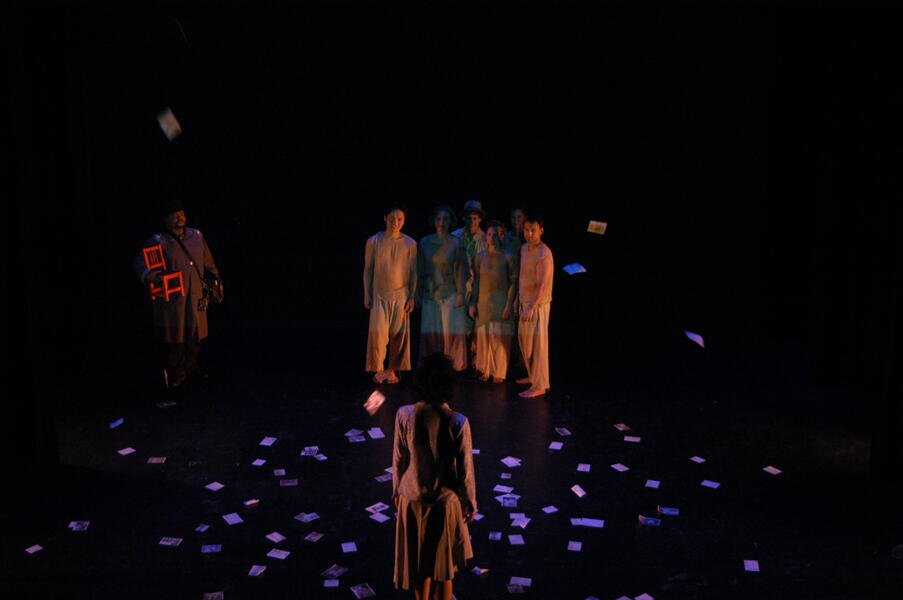 The Voyage (2004)@ Baltimore Theatre Project, MD"The Voyage is best experienced by letting it wash over you, instead of attempting to attach a meaning. The final image is that of photos falling like leaves onto the stage. Gentler than some of the angst that precedes it, this image evokes memories, suggesting perhaps that life's journey is not in vain, but captured and preserved for future travelers." - Baltimore Sun
The Voyage (2004)@ Baltimore Theatre Project, MD"The Voyage is best experienced by letting it wash over you, instead of attempting to attach a meaning. The final image is that of photos falling like leaves onto the stage. Gentler than some of the angst that precedes it, this image evokes memories, suggesting perhaps that life's journey is not in vain, but captured and preserved for future travelers." - Baltimore Sun -
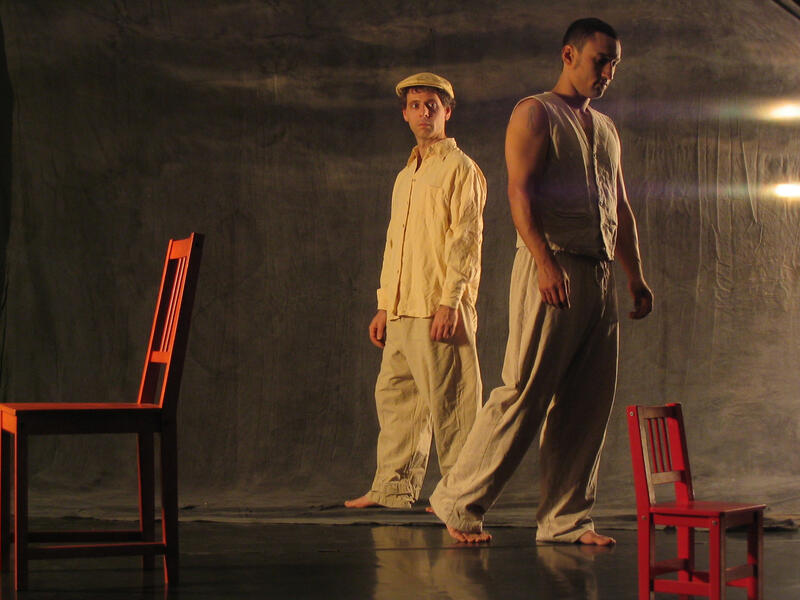 The Voyage (2004)@ Baltimore Theatre Project, MD"Naoko give experiences. Fleeting, meaningful, and like a powerful dream, they stay and paint the days to come in marvelous colors." - Mara Neimanis
The Voyage (2004)@ Baltimore Theatre Project, MD"Naoko give experiences. Fleeting, meaningful, and like a powerful dream, they stay and paint the days to come in marvelous colors." - Mara Neimanis -
 The Voyage (2004)@ Baltimore Theatre Project, MDLater, in a section called "Liquid Rumble," Dan Awkward, a performer dressed as what appears to be either a train conductor or a military officer, removes a large glass bowl from a valise and places it on the flat top of the cap on his head. Slowly, a trail of sand begins falling from the ceiling and filling the bowl. This could be intended to represent the sands of time, but I suspect that's too glib an interpretation for this wide-ranging, multicultural performance piece. - The Baltimore Sun
The Voyage (2004)@ Baltimore Theatre Project, MDLater, in a section called "Liquid Rumble," Dan Awkward, a performer dressed as what appears to be either a train conductor or a military officer, removes a large glass bowl from a valise and places it on the flat top of the cap on his head. Slowly, a trail of sand begins falling from the ceiling and filling the bowl. This could be intended to represent the sands of time, but I suspect that's too glib an interpretation for this wide-ranging, multicultural performance piece. - The Baltimore Sun
Returning to the FULL CIRCLE: Subject/Object (2016)
SUBJECT/OBJECT (2016) - full-length
Concept, choreography, direction, environment/object co-design, and performance
“Subject/Object” is a solo performance project that investigates the nature of ‘self’ through deconstruction and redefinition. Through three elements, Breathing, Digestive system, and Skin, I explored what lurked beneath this entity called 'self'. During the process, each element found its own form of theatrical expression. 'Breathing' led to the descent through a womb into birth. 'Digestive system' was married to a comedy about laughter in Japan. 'Skin' was explored through the cellular vibration outside and inside of the skin.
The first part (Breath) took place in the regular audience section, which was turned into a vast field covered with plastic, forming a gigantic womb-like environment.
The second part (Tube) used the stage as a shared space with the audience, creating a warm and cozy space where personal stories were shared.
The last past (Skin) happened in the dome-shaped part at the very back of the stage space.
Material – Plastic, water, salt
Lighting design by David Crandall
Sound/Music by Khristian Weeks
Environment desing by Khristian Weeks and Naoko Maeshiba
Object design and costume by Naoko Maeshiba
Received Best Performance Artist Award in Citypaper Best of Baltimore 2016.
Premiere - June 2016 @ Baltimore Theatre Project
Concept, choreography, direction, environment/object co-design, and performance
“Subject/Object” is a solo performance project that investigates the nature of ‘self’ through deconstruction and redefinition. Through three elements, Breathing, Digestive system, and Skin, I explored what lurked beneath this entity called 'self'. During the process, each element found its own form of theatrical expression. 'Breathing' led to the descent through a womb into birth. 'Digestive system' was married to a comedy about laughter in Japan. 'Skin' was explored through the cellular vibration outside and inside of the skin.
The first part (Breath) took place in the regular audience section, which was turned into a vast field covered with plastic, forming a gigantic womb-like environment.
The second part (Tube) used the stage as a shared space with the audience, creating a warm and cozy space where personal stories were shared.
The last past (Skin) happened in the dome-shaped part at the very back of the stage space.
Material – Plastic, water, salt
Lighting design by David Crandall
Sound/Music by Khristian Weeks
Environment desing by Khristian Weeks and Naoko Maeshiba
Object design and costume by Naoko Maeshiba
Received Best Performance Artist Award in Citypaper Best of Baltimore 2016.
Premiere - June 2016 @ Baltimore Theatre Project
-
Subject/Object (2016)SUBJECT/OBJECT (2016) - full-length Concept, choreography, direction, environment/object co-design, and performance “Subject/Object” is a solo performance project that investigates the nature of ‘self’ through deconstruction and redefinition. Through three elements, Breathing, Digestive system, and Skin, I explored what lurked beneath this entity called 'self'. During the process, each element found its own form of theatrical expression. 'Breathing' led to the descent through a womb into birth. 'Digestive system' was married to a comedy about laughter in Japan. 'Skin' was explored through the cellular vibration outside and inside of the skin.
-
 Subject/Object
Subject/Object -
 Subject/Object
Subject/Object -
 Subject/Object
Subject/Object -
 Subject/Object
Subject/Object -
 Subject/Object
Subject/Object -
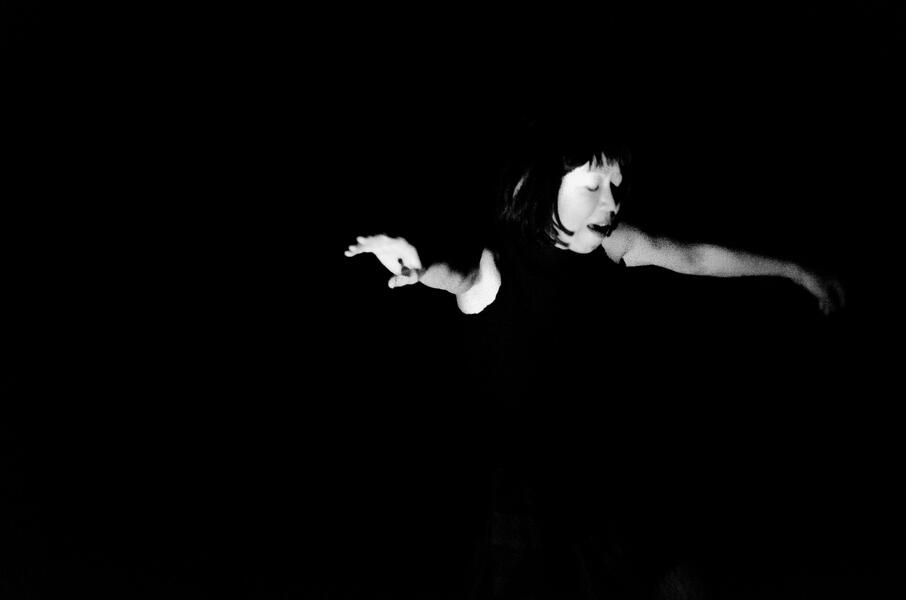 Subject/Object
Subject/Object -
 Subject/Object
Subject/Object -
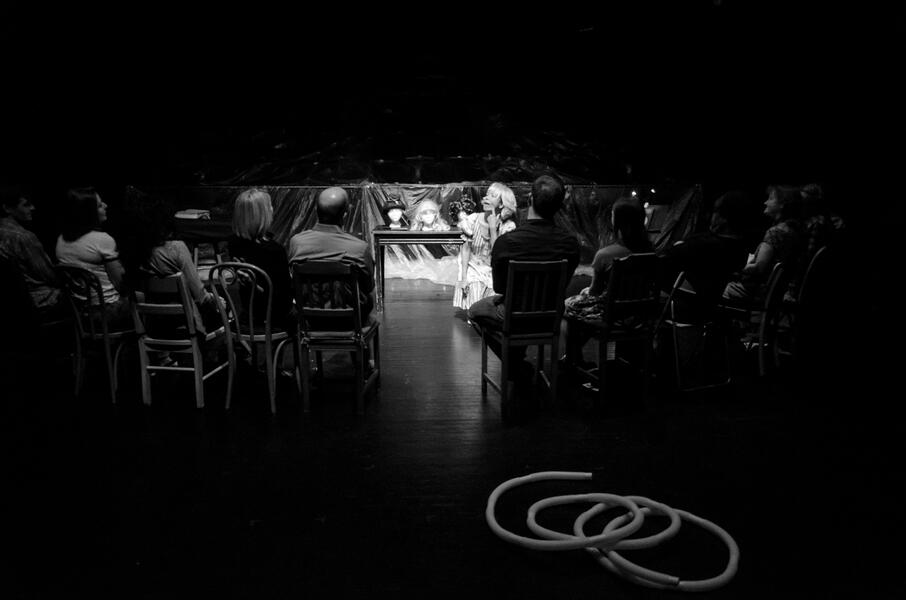 Subject/Object
Subject/Object -
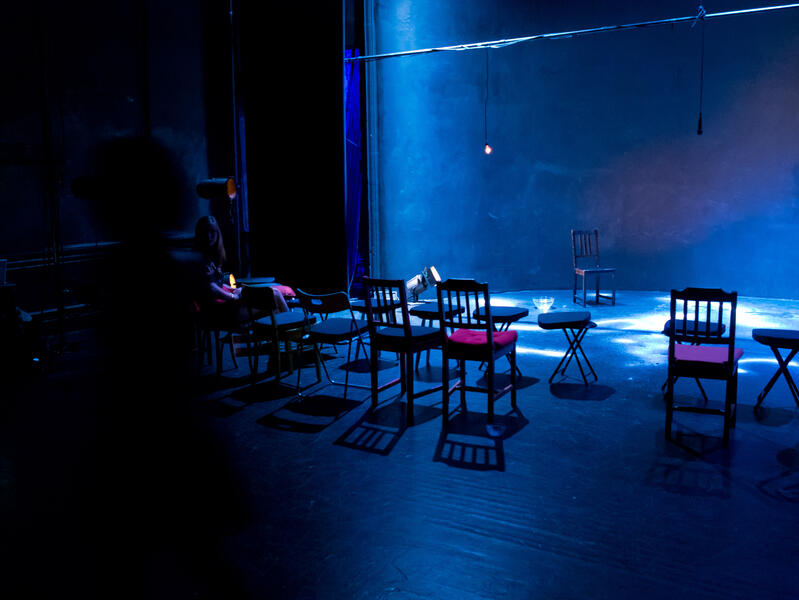 Subject/Object
Subject/Object
DUO CONSPIRACIES
Having a partner-in-crime is a thrilling, assuring, and nerving experience. I step into an unfamiliar territory where I might lose my ground any time. It's scary and joyful to see how my body responds to the new stimuli.
*****************************************************************************************
IMPROBABLE ENCOUNTER (2006) @ Klub Kaliska, Lodz, Poland
Darius Makaruk (musician) and I first started with a long-distance communication, discussing the structure of the piece, its central theme, and the feel and progression of the performance. We worked separately until we finally got together at the site of performance in Poland. Improbable Encounter was a structured improvisation of about an hour’s length. This was the first time I did a full evening length’s dance piece in which I was the only dancer. Darius brought in another musician, Wlodzimierz Kiniorski, a legendary figure in Lodz, Poland. Klub Kaliska, a music venue in Lodz, was packed with curious audience. I started to work more in solo and duo pieces after returning from this experience.
ABSENCE (2007) @ M25, Warsaw, Poland
Darius Makaruk and I took a similar format of collaboration as the previous piece. This time, I brought another dancer to work in the piece. With two dancers, I was able to bring 'relationships' into the context. "Absence" was constructed more like a play with abstracted narrative.
STRIPPED BARE (2010) @ Art Gallery, University of Maryland, College Park
This piece happened in conjunction of the group exhibit and conference, "Modernity stripped bare: Undressing the Nude in Contemporary Japanese Photography".With a Japanese electronic musician, Yoko K. drawing inspiration from a Japanese photographer Riichi Yamaguchi's work. As a part of the process I interviewed Riichi to find out his approach to photographing nude bodies. This interview appeared in the exhibition catalog. Yoko and I worked in the gallery day after day, contemplating what we, two Japanese women, could bring out of these intense nude photographs. The title of the piece changed from "Shining Fish: Modernity Stripped Bare" to "Stripped Bare" to reflect the simple and raw nature of the photography.
APERTURE (2012) - @ Tank, New York
I had always loved the tactile sensation in Andy Hayleck's music and proposed to work with him. We started with what was in the performance space - a piano. Over a period of three months, we concocted a physical poetry with colliding elements of silence and sound, body and space, and the visible and the invisible. This piece became the foundation of the piece we later created called "Plasmic Patterns".
THE PEEL (2004) @ 14 Karat Cabaret, Baltimore
This is an earlier, memorable work with Audrey Chen (cello, voice). We decided to literally 'peel off' a skin made of glue put on the body during the performance. We tried to see how this experience affected my dance and her voice.
*****************************************************************************************
IMPROBABLE ENCOUNTER (2006) @ Klub Kaliska, Lodz, Poland
Darius Makaruk (musician) and I first started with a long-distance communication, discussing the structure of the piece, its central theme, and the feel and progression of the performance. We worked separately until we finally got together at the site of performance in Poland. Improbable Encounter was a structured improvisation of about an hour’s length. This was the first time I did a full evening length’s dance piece in which I was the only dancer. Darius brought in another musician, Wlodzimierz Kiniorski, a legendary figure in Lodz, Poland. Klub Kaliska, a music venue in Lodz, was packed with curious audience. I started to work more in solo and duo pieces after returning from this experience.
ABSENCE (2007) @ M25, Warsaw, Poland
Darius Makaruk and I took a similar format of collaboration as the previous piece. This time, I brought another dancer to work in the piece. With two dancers, I was able to bring 'relationships' into the context. "Absence" was constructed more like a play with abstracted narrative.
STRIPPED BARE (2010) @ Art Gallery, University of Maryland, College Park
This piece happened in conjunction of the group exhibit and conference, "Modernity stripped bare: Undressing the Nude in Contemporary Japanese Photography".With a Japanese electronic musician, Yoko K. drawing inspiration from a Japanese photographer Riichi Yamaguchi's work. As a part of the process I interviewed Riichi to find out his approach to photographing nude bodies. This interview appeared in the exhibition catalog. Yoko and I worked in the gallery day after day, contemplating what we, two Japanese women, could bring out of these intense nude photographs. The title of the piece changed from "Shining Fish: Modernity Stripped Bare" to "Stripped Bare" to reflect the simple and raw nature of the photography.
APERTURE (2012) - @ Tank, New York
I had always loved the tactile sensation in Andy Hayleck's music and proposed to work with him. We started with what was in the performance space - a piano. Over a period of three months, we concocted a physical poetry with colliding elements of silence and sound, body and space, and the visible and the invisible. This piece became the foundation of the piece we later created called "Plasmic Patterns".
THE PEEL (2004) @ 14 Karat Cabaret, Baltimore
This is an earlier, memorable work with Audrey Chen (cello, voice). We decided to literally 'peel off' a skin made of glue put on the body during the performance. We tried to see how this experience affected my dance and her voice.
-
Stripped Bare (2011) - with Yoko K. (singer/electronic musician) - performance in the exhibit 'Modernity stripped bare: Undressing the Nude in Contemporary Japanese Photography' @ Art Gallery, University of Maryland, College Park, choreography/performance"JB: What do you look for when you pick music for your pieces? NM: I’m looking for music that doesn’t explain or define. I’m looking for music that does something more than conserve your feelings. It creates tensions between body and the mind, and with the audience. I try to use it to break catharsis." (DC Theatre Scene interview: Dancing on the edge of theatre)
-
 Stripped Bare (2011) @ in conjunction of the exhibit/conference, 'Modernity stripped bare: Undressing the Nude in Contemporary Japanese Photography @ Art Gallery, University of Maryland, College ParkI had never been in a place with this many intense nude photographs by contemporary Japanese artists. The voice in each photograph was so strong that I was sometimes at a loss as to what I can do inside of these powerful voices. Yoko and I worked in the gallery, day after day trying out different materials to find a way to exist in this impregnated space.
Stripped Bare (2011) @ in conjunction of the exhibit/conference, 'Modernity stripped bare: Undressing the Nude in Contemporary Japanese Photography @ Art Gallery, University of Maryland, College ParkI had never been in a place with this many intense nude photographs by contemporary Japanese artists. The voice in each photograph was so strong that I was sometimes at a loss as to what I can do inside of these powerful voices. Yoko and I worked in the gallery, day after day trying out different materials to find a way to exist in this impregnated space. -
Aperture (2010) - with Andy Hayleck (musician) - Eavesdropping Series @ Tank, New York - choreography/costume and lighting design/performance"Aperture" was with a musician, Andy Hayleck. We started with what is in the performance space at Tank, NYC. Over a period of three months, we concocted a physical poetry with colliding elements of silence and sound, body and space, and the visible and the invisible.
-
 Aperture (2010) - Eavesdropping Series @ Tank, New YorkThe piano in the space became a central motif of the piece. It transformed into a wall, an object as well as an instrument Andy played during the show by bowing the strings inside of the piano.
Aperture (2010) - Eavesdropping Series @ Tank, New YorkThe piano in the space became a central motif of the piece. It transformed into a wall, an object as well as an instrument Andy played during the show by bowing the strings inside of the piano. -
Improbable Encounter (2006) - with Darius Makaruk (musician) - The 5th Dialogue of Four Cultures Festival @ Klub Kaliska, Lodz, Poland - full length - choreography/performance"Naoko's dancing body is a close combination of calligraphy, lyrics, and depth...Her body creates an invisible border of the inside and outside, a dancing edge, which becomes an opening, drawing apart the feeling of joy, suffering, happiness, warmth, and despair. It binds together the present, the past, and the future. Her body is a means of possessing the world." - Janusz Raczkiewicz
-
 Improbable Encounter (2006)- The 5th Dialogue of Four Cultures Festival @ Klub Kaliska, Lodz, PolandImprobable Encounter was a structured improvisation of about an hour’s length. This was the first time I did a full evening length’s solo dance piece.The club was packed with curious audience. I came back from Poland and started doing more solo and short pieces.
Improbable Encounter (2006)- The 5th Dialogue of Four Cultures Festival @ Klub Kaliska, Lodz, PolandImprobable Encounter was a structured improvisation of about an hour’s length. This was the first time I did a full evening length’s solo dance piece.The club was packed with curious audience. I came back from Poland and started doing more solo and short pieces. -
Absence (2007) - with Dariuz Makaruk (musician) - International New Media Festival: Moving Closer @ M25, Warsaw, Poland - full-length - choreography/environment and costume design/performance"Absence" was performed in a remodeled old elementary school building in Warsaw. Darius and I worked over distance initially, then integrated what we brought on the site. Tatsuya Aoyagi ,performer, and a legendary musician, Wlodzimierz Kiniorski joined us later.
-
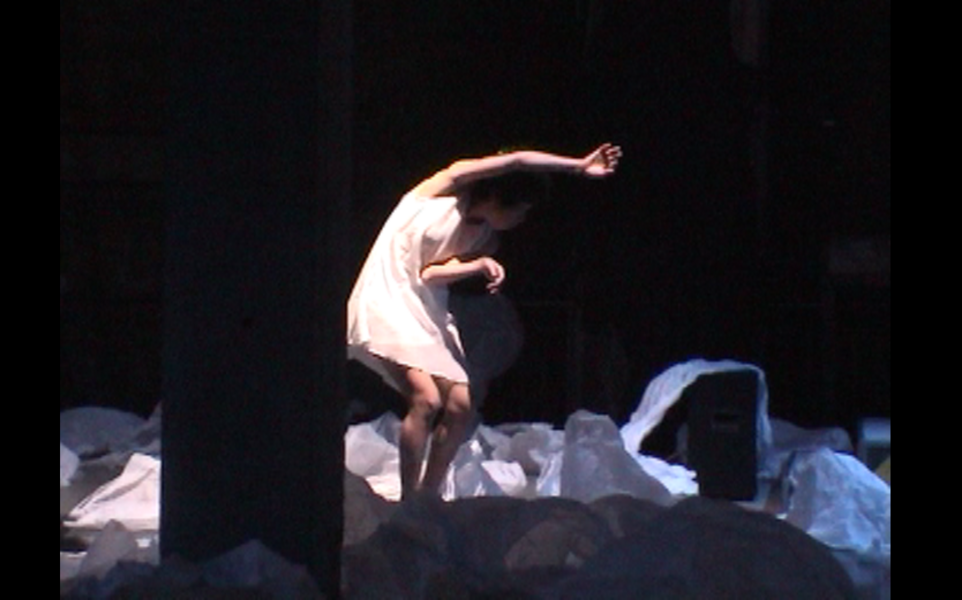 Absence (2007) - International New Media Festival: Moving Closer @ M25, Warsaw, Poland"...Later on I did a piece called "Absence". Now, this was like a play. There was dramaturgy. But the narratives are rather abstract. So I write a scenario, with characters. So it progresses. It’s just that the performers are not speaking. They’re dancing or moving. And this might be the influence of the Japanese director, Ota Shogo. He came out in the era where Japan was going through this era of modernization." (DC Theatre Scene interview: Dancing on the edge of theatre)
Absence (2007) - International New Media Festival: Moving Closer @ M25, Warsaw, Poland"...Later on I did a piece called "Absence". Now, this was like a play. There was dramaturgy. But the narratives are rather abstract. So I write a scenario, with characters. So it progresses. It’s just that the performers are not speaking. They’re dancing or moving. And this might be the influence of the Japanese director, Ota Shogo. He came out in the era where Japan was going through this era of modernization." (DC Theatre Scene interview: Dancing on the edge of theatre) -
The Peel (2005) - with Audrey Chen (voice/cellist), 14 Karat Cabaret @ 14 Karat, BaltimoreThis is an earlier, memorable work with Audrey Chen (cello, voice). We decided to literally 'peel off' a skin made of glue put on the body during the performance. We tried to see how this experience affected my dance and her voice.
-
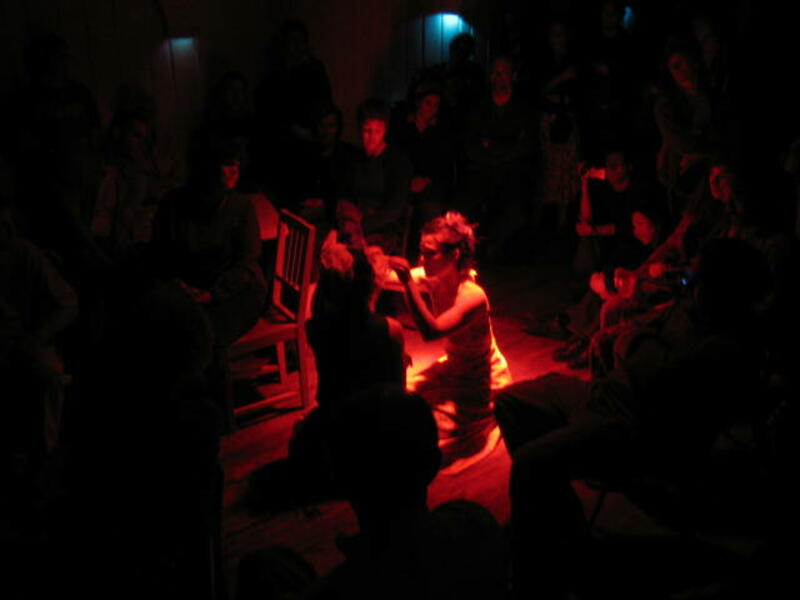 The Peel (2005) - 14 Karat Cabaret @ 14 Karat, BaltimoreTowards the end of the performance, two performers go through the ritual of peeling the mask off of each other, surrounded by the audience.
The Peel (2005) - 14 Karat Cabaret @ 14 Karat, BaltimoreTowards the end of the performance, two performers go through the ritual of peeling the mask off of each other, surrounded by the audience.
BODY AND ENVIRONMENT SITE STUDY
Places outside of the theatre space are unregulated. I could disappear or appear in the landscape anytime. How can I exist in a place without dominating it or isolating myself from it? Can my body be a part of the landscape? Can it become an environment within the environment? How can I form a relationship with the place? I plan to continue and deeper this study in the near future.
******************************************************************************************
WHEN THE WIND CROSSED MY BODY CRIED LIKE AN OCTOPUS (2010)
Site #1 - Bridge that separates old town from new town
Site #2 - Under the small bridge over a river in the center of the city
Site #3 - Theatre Jo at CESTA (Cultural Exchange Station in Tabor), Tabor, Czech Republic
This is a three-part performance project, examining how the sensation of movements in the body can be transmitted from one location to another. First two were done in specific sites near CESTA (Cultural Exchange Station) in Tabor where I was conducting an artist residency. First site was under the bridge which severs the old town and the new town. The second site was in the river in the center of the old town. The last part was presented in the theatre inside CESTA, drawing the traces left in my body through the previous two studies. I continued to carry the magic mirrors from "Face of Another (2010)" and "Modernity Stripped Bare (2011)". My deep curiosity about 'self' was starting to emerge through this project.
GYROSCOPE PROJECT (2003)
Site - Exterior of Hirschhorn Museum of Smithsonian Institute, DC
A site-specific performance in conjunction with the museum’s exhibit, “Gyroscope." This solo section was incorporated in an ensemble piece with ten performers and one live musician who worked with the exhibits inside and outside of the museum. The wind, surrounding audience, the sound of the fountain, and splashing water, all gave me great stimuli to work with. I clearly remember the moment I laid my whole body on the ledge of the fountain which was about six inches wide.
SOLO DANCE (2008)
Site - A selected landscape in Hakushu, Japan
I returned to this place where I started my artistic journey in 1993. I wanted to see how my body and mind remembered this place. Each of the invited dancers selected a specific site for her work. I chose this site because I was drawn to the beautiful backdrop of nature which contrasted with the dry field in front that had nothing growing at the time. The performance lasted 70 minutes. This piece was performed as a part of Dance Hakushu Festival, a multidisciplinary performance festival that has brought all kinds of artists from far away and close since 1988.
A ROSE IN THE WILD (2007)
Site - Exterior of Martin Luther King Library
This performance happened twice on the same day - 1pm and 5pm. The passing time
THE HOLE (2002)
Site - Interior of the building of Center for the Arts @ Towson University
I fell in love with a student's art exhibit called "Biodegradable" that was installed n the jI fell in love with a student's art installation called "Biodegradable" that was built in the juncture of the staircases extending to the basement. I wondered what the journey would be like to descend into this long tunnel made of plastic bags and trash. Gabriel Walked accompanied me on this journey with his Shakuhachi.
******************************************************************************************
WHEN THE WIND CROSSED MY BODY CRIED LIKE AN OCTOPUS (2010)
Site #1 - Bridge that separates old town from new town
Site #2 - Under the small bridge over a river in the center of the city
Site #3 - Theatre Jo at CESTA (Cultural Exchange Station in Tabor), Tabor, Czech Republic
This is a three-part performance project, examining how the sensation of movements in the body can be transmitted from one location to another. First two were done in specific sites near CESTA (Cultural Exchange Station) in Tabor where I was conducting an artist residency. First site was under the bridge which severs the old town and the new town. The second site was in the river in the center of the old town. The last part was presented in the theatre inside CESTA, drawing the traces left in my body through the previous two studies. I continued to carry the magic mirrors from "Face of Another (2010)" and "Modernity Stripped Bare (2011)". My deep curiosity about 'self' was starting to emerge through this project.
GYROSCOPE PROJECT (2003)
Site - Exterior of Hirschhorn Museum of Smithsonian Institute, DC
A site-specific performance in conjunction with the museum’s exhibit, “Gyroscope." This solo section was incorporated in an ensemble piece with ten performers and one live musician who worked with the exhibits inside and outside of the museum. The wind, surrounding audience, the sound of the fountain, and splashing water, all gave me great stimuli to work with. I clearly remember the moment I laid my whole body on the ledge of the fountain which was about six inches wide.
SOLO DANCE (2008)
Site - A selected landscape in Hakushu, Japan
I returned to this place where I started my artistic journey in 1993. I wanted to see how my body and mind remembered this place. Each of the invited dancers selected a specific site for her work. I chose this site because I was drawn to the beautiful backdrop of nature which contrasted with the dry field in front that had nothing growing at the time. The performance lasted 70 minutes. This piece was performed as a part of Dance Hakushu Festival, a multidisciplinary performance festival that has brought all kinds of artists from far away and close since 1988.
A ROSE IN THE WILD (2007)
Site - Exterior of Martin Luther King Library
This performance happened twice on the same day - 1pm and 5pm. The passing time
THE HOLE (2002)
Site - Interior of the building of Center for the Arts @ Towson University
I fell in love with a student's art exhibit called "Biodegradable" that was installed n the jI fell in love with a student's art installation called "Biodegradable" that was built in the juncture of the staircases extending to the basement. I wondered what the journey would be like to descend into this long tunnel made of plastic bags and trash. Gabriel Walked accompanied me on this journey with his Shakuhachi.
-
 When the wind crossed my body cried like an octopus (2010) @ CESTA, Tabor, Czech Republic"NM: Tabor. This was three hours from Prague. I was given the time and space to really face myself by myself, and the place was so supportive. I took walks every morning. I just wanted to be around the city. I did two dance studies there. One study was in the river. It was a strong current. I was descending. I was sitting on a chair. There was a pool underneath. I was coming down to a ledge above the pool. I knew the pool was really shallow. There was no danger. I was really stuck on this ledge. I had a hard time going down there. I didn’t want to show fear. I was kind of dancing, thinking, ‘I have to go I have to go,’ and it was really cold, and then, finally, I decided, I’m going to go, one two three. And then, one two three, and I dived in. I was floating. Then I was sinking. I had to swim. And I was cold, so I had to get out of the water. That experience was so strong." - DC Theatre Scene
When the wind crossed my body cried like an octopus (2010) @ CESTA, Tabor, Czech Republic"NM: Tabor. This was three hours from Prague. I was given the time and space to really face myself by myself, and the place was so supportive. I took walks every morning. I just wanted to be around the city. I did two dance studies there. One study was in the river. It was a strong current. I was descending. I was sitting on a chair. There was a pool underneath. I was coming down to a ledge above the pool. I knew the pool was really shallow. There was no danger. I was really stuck on this ledge. I had a hard time going down there. I didn’t want to show fear. I was kind of dancing, thinking, ‘I have to go I have to go,’ and it was really cold, and then, finally, I decided, I’m going to go, one two three. And then, one two three, and I dived in. I was floating. Then I was sinking. I had to swim. And I was cold, so I had to get out of the water. That experience was so strong." - DC Theatre Scene -
When the wind crossed my body cried like an octopus (2010) - Under the bridge that severs old town and new town and in the river @ CESTA, Tabor, Czech RepublicThis is a three-part performance project, examining how the sensation of movements in the body can be transmitted from one location to another. First two were done in specific sites near CESTA (Cultural Exchange Station) in Tabor where I was conducting an artist residency. First site was under the bridge which severs the old town and the new town. The second site was in the river in the center of the old town. The last part was presented in the theatre inside CESTA, drawing the traces left in my body through the previous two studies.
-
 Gyroscope Project (2004) @ Hirshhorn Museum and Sculpture Garden, Washington, D.C.The wind, surrounding audience, the sound of the fountain, and splashing water, all gave me great stimuli to work with. I clearly remember the moment I laid my whole body on the ledge of the fountain which was about six inches wide. When I arrived at the destination, the whole surface of my back merged with the rising and falling water of the fountain.
Gyroscope Project (2004) @ Hirshhorn Museum and Sculpture Garden, Washington, D.C.The wind, surrounding audience, the sound of the fountain, and splashing water, all gave me great stimuli to work with. I clearly remember the moment I laid my whole body on the ledge of the fountain which was about six inches wide. When I arrived at the destination, the whole surface of my back merged with the rising and falling water of the fountain. -
Gyroscope Project (2004)- Exterior of the museum @ Hirshhorn Museum and Sculpture Garden, Washington, D.C.A site-specific performance in conjunction with the museum’s exhibit, “Gyroscope." This solo section was incorporated in an ensemble piece with ten performers and one live musician who interacted with the exhibits inside and outside of the museum.
-
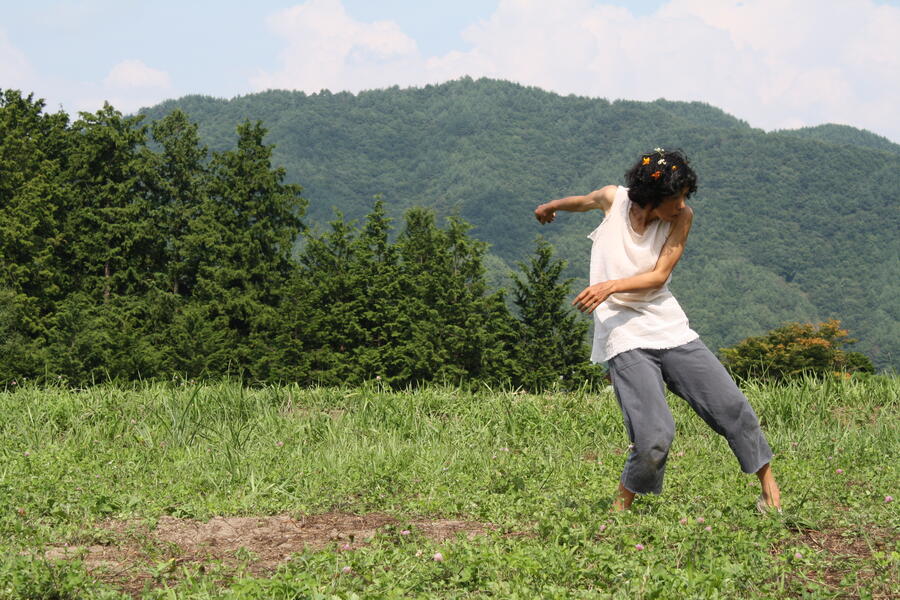 Solo Dance (2008) @ Dance Hakushu Festival, Hakushu, JapanAfter each dance was performed, a talk session was held with the modern philosophers and the dance critics. My respondent was Kuniichi Uno, whose specialty was Bodymedia theory. “Uno: ...Today, I was wondering how a dancer and the audience live the time that continues to flow without any break. I was watching your dance through this lens perhaps because it might be connected to I’ve been thinking lately. But I think it is largely because the way you danced today. It evoked symbolism. I was thinking, if you melt into that hole, what would happen to her? Death? I was shocked. I understand what you meant by ‘wearing the dirt’. It felt to me that you were going through the process of ‘wearing time’, weaving the time of this place continuously. It looked like it was going to end, but it didn’t end, which is in line with what you said that the piece is not about meaning. Maeshiba: When I direct an existing scripted play, I need to be meticulously searching for a reason. When I dance, I don’t want to have a reason constructed by my mind. For this performance, I was trying to do something that has no meaning but expands audience imagination.” – ‘Let’s talk about dance’ – a post performance talk in Dance Hakushu 2008
Solo Dance (2008) @ Dance Hakushu Festival, Hakushu, JapanAfter each dance was performed, a talk session was held with the modern philosophers and the dance critics. My respondent was Kuniichi Uno, whose specialty was Bodymedia theory. “Uno: ...Today, I was wondering how a dancer and the audience live the time that continues to flow without any break. I was watching your dance through this lens perhaps because it might be connected to I’ve been thinking lately. But I think it is largely because the way you danced today. It evoked symbolism. I was thinking, if you melt into that hole, what would happen to her? Death? I was shocked. I understand what you meant by ‘wearing the dirt’. It felt to me that you were going through the process of ‘wearing time’, weaving the time of this place continuously. It looked like it was going to end, but it didn’t end, which is in line with what you said that the piece is not about meaning. Maeshiba: When I direct an existing scripted play, I need to be meticulously searching for a reason. When I dance, I don’t want to have a reason constructed by my mind. For this performance, I was trying to do something that has no meaning but expands audience imagination.” – ‘Let’s talk about dance’ – a post performance talk in Dance Hakushu 2008 -
Solo Dance (2008)- A selected site in the village of Hakushu @ Dance Hakushu Festival, Solo Dance series, Hakushu, JapanI returned to this place where my journey as a dancer started in 1993. I wanted to see how my body and mind remembered this place. In this series called 'Solo Dance', each of the invited dancers selected a specific site for her dance. I was drawn to the landscape of this site which made a contrast with the dry flat field which had nothing growing at the time. This 70-minute piece was performed as a part of Dance Hakushu Festival, an international performing art festival with 20 years of history.
-
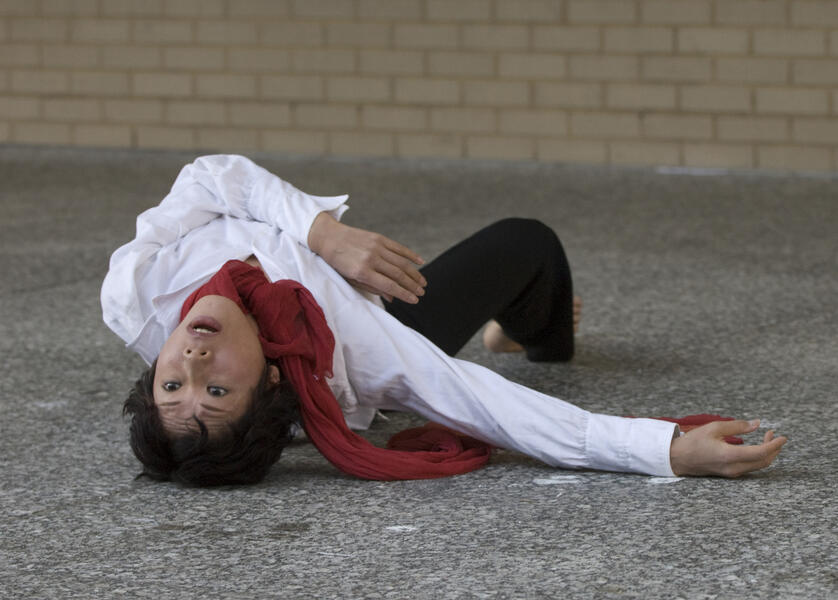 A Rose in the Wild (2007) @ Exterior of Martin Luther King Library in Washington, D.C."…Maeshiba excelled at adapting to her environment." – The Washington Post
A Rose in the Wild (2007) @ Exterior of Martin Luther King Library in Washington, D.C."…Maeshiba excelled at adapting to her environment." – The Washington Post -
A Rose in the Wild (2007)- Exterior of Martin Luther King Library @ The 13th annual International Improvisation Festival, Washington, D.C."Soloist Naoko Maeshiba dealt masterfully with some challenging interlopers.Also performing outside the library, Maeshiba capitalized on the proximity of her audience with minute wiggles of a single finger or toe. These movements would have been almost undetectable in a traditional theater setting." – The Washington Post
-
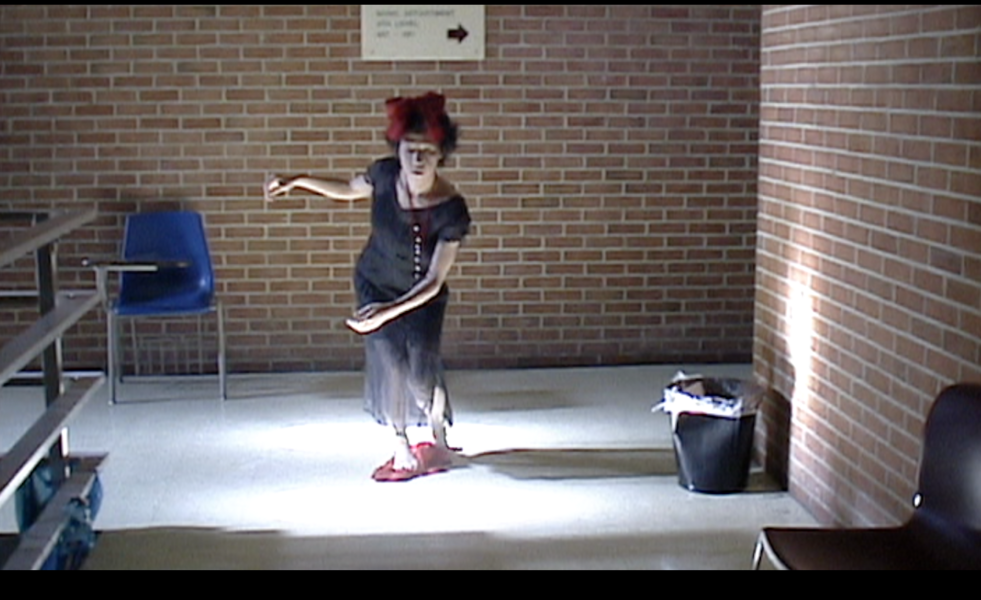 The Hole (2002) @ Center for the Arts building, Towson University, MDI fell in love with a student's art installation called "Biodegradable" that was built in the juncture of the staircases extending from the fourth floor to the basement. I wondered what the journey would be like to descend into this long tunnel made of plastic bags and trash. Gabriel Walked accompanied me on this journey with his Shakuhachi.
The Hole (2002) @ Center for the Arts building, Towson University, MDI fell in love with a student's art installation called "Biodegradable" that was built in the juncture of the staircases extending from the fourth floor to the basement. I wondered what the journey would be like to descend into this long tunnel made of plastic bags and trash. Gabriel Walked accompanied me on this journey with his Shakuhachi. -
The Hole (2002) - Interior of the Center for the Arts building @ Towson University, MDIn this study, I'm exploring the interior of the center for the arts building at Towson University. with Gabriel Walker, the musician, and the installation called 'Biodegradable' on the site.
